Celebrating 20 Years of Backcountry Hunters & Anglers Fall 2024


Celebrating 20 Years of Backcountry Hunters & Anglers Fall 2024





I didn’t grow up in a family that hunted or fished. There was no “YouTube University” or curated social media feed to cultivate my interest in outdoor adventures. Occasionally, I could find books, magazines, or a hand-me-down VHS tape, but pickin’s were slim. So, like many of us, I made it up as I went along, learned by screwing up, and prayed someone would save me from myself. It was this last strategy – by far – that was the most valuable.
Personally, I can’t imagine where I’d be as a sportsman and conservationist if it weren’t for the remarkable people who helped guide my journey. From these generous mentors I learned not only how to make a turkey call out of a straw, how to rig a drop shot, how to tie a fly and how NOT to call a duck, but I also gleaned something equally important – the intrinsic value of wild country and a desire to safeguard it.
Fly fishing luminary and noted conservation advocate Lee Wulff once said, “Every time you teach someone to fly fish, you’ve just created a new conservationist.” That truth extends to many outdoor pursuits. As the world evolves around us, acceptance of hunting by the general public is on the decline, and the sanctity of landscapes that support healthy wildlife populations are under increasing threat; mentorship matters more now than ever before.
As our primary focus, Backcountry Hunters & Anglers stands guard as the watchdog for our wild public lands, waters, and wildlife. To achieve greater mission impact, we encourage others to join the BHA community as members, advocates, and future leaders. But not all come to the table as experts with the skills needed to effectively wield a shotgun, rifle, bow, or fishing rod – or sometimes even to look through the proper end of a pair of binoculars. Others need to be encouraged to stand tall as advocates for public lands, access and opportunity, and conservation of the wild places that feed our souls.
Sometimes mentorship happens organically. Other times it happens through programs designed to cultivate a love of the outdoors and teach the skills needed to be successful in the field or on the water. Those “official” programs fall under the category of “R3,” the shorthand term for recruitment, retention and reactivation. The
goal of R3 is to increase participation in hunting, fishing, trapping, boating and shooting sports. But whether mentorship happens informally or through a pre-designed program, the value often remains the same.
At a fundamental level, aspiring newcomers to the world of hunting and fishing not only learn key skills, but they also often learn etiquette that can make for a more enjoyable outdoor experience for all – such as give other anglers plenty of space, get the cooler and gear ready before the boat is backed down the ramp, and drive past your desired hunting spot if there’s another truck already parked there. Seems like obvious stuff, right? Well, not always. That’s why we often need mentors to show the way.
There’s a little-known podcast host whose favorite pastime is to publicly bludgeon individuals and organizations who take on the selfless and laudable role of mentors to wide-eyed novice hunters eager to learn. To me, slamming the door to opportunity behind you by shaming volunteers dedicated to inspiring the next generation of outdoor enthusiasts is like kicking a puppy across the room. It also has lasting consequences. Trying to make the tent as tiny as possible while the percentage of non-hunters skyrockets into the stratosphere is a recipe for irrelevance and bad policy outcomes.
Mentors share their hunting and fishing knowledge, nurture a passion for adventure, open the door to backcountry experiences, encourage grassroots engagement, teach people how to play nice with others, and instill an enduring conservation ethic. It’s through these experiences that a community is formed – BHA – where we not only share our passions, but we unite to protect the wildlife and wild places that those passions are dependent upon.
Without someone holding the light to guide our path, we’d spend more time lost than found, and fall farther behind in the race to save the last best places. I am damn proud of the mentors across BHA who help inspire and grow the community of ethical, conservationminded hunters and anglers. You have my deepest gratitude.
-Patrick Berry, President & CEO
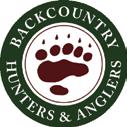
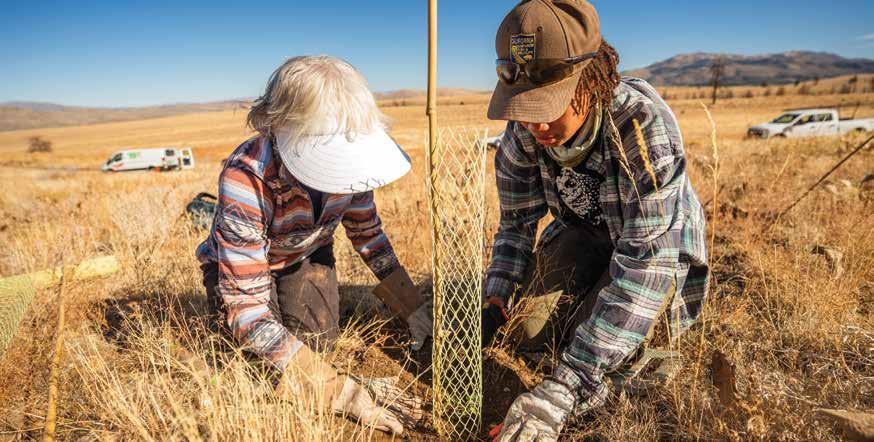
“I know of no restorative of heart, body, and soul more effective against hopelessness than the restoration of the Earth.”
- Barry Lopez
Ryan Callaghan (Montana) Chairman
Dr. Christopher L. Jenkins (Georgia) Vice Chair
Jeffrey Jones (Alabama) Treasurer
Katie Morrison (Alberta) Secretary
Patrick Berry, President & CEO
Frankie McBurney Olson, Vice President of Operations
Dr. Keenan Adams (Puerto Rico)
Bill Hanlon (British Columbia)
Jim Harrington (Michigan)
Hilary Hutcheson (Montana)
Ted Koch (Idaho)
Nadia Marji, Vice President of Marketing and Communications
Katie DeLorenzo, Western Field Director
Britney Fregerio, Director of Finance
Chris Hennessey, Eastern Field Director
Dre Arman, Chapter Coordinator (ID, NV)
Brian Bird, Chapter Coordinator (NJ, NY, New England)
Chris Borgatti, Eastern Policy and Conservation Manager
Kylee Burleigh, Digital Media Coordinator
Tiffany Cimino, Membership and Community Development Manager
Trey Curtiss, Strategic Partnerships and Conservation Programs Manager
Bard Edrington V, Habitat Stewardship Coordinator (NM)
Brady Fryberger, Office Manager
Mary Glaves, Chapter Coordinator (AK)
Chris Hager, Chapter Coordinator (WA, OR)
Andrew Hahne, Habitat Stewardship Coordinator (MT, ID, WY)
On the Cover: Celebrating 20 years of BHA with the evolution of Backcountry Journal over the years and a few of our favorite covers.
Above Image: Planting at Beer, Bands & Bitterbrush Stands. (Learn more on page 32.) Photo by Travis Bradford
Jay Beyer, Charlie Booher, Travis Bradford, Jamie Cameron, Will Caverly, Jan Dizard, Holly Endersby, Jillian Garrett, Matt Groce, Andrwe Hahne, Tony Heckard, Abby Hutcheson, Kobe Jackson, Bryan Jones, Kyle Klain, Don Klebenow, Nathan Kunze, JJ Laberge, Jake Forrest Lunsford, Kaden McArthur, Claire McAtee, Jesse C. McEntee, Devin O’Dea, Shane Oehler, Jeffrey Petersen, Cody Readinger, Ron Rohrbaugh, Sean Stiny, Josh Suggs, Jenny Nguyen-Wheatley, Kassie Yeager
Journal Submissions: williams@backcountryhunters.org
Advertising and Partnership Inquiries: mills@backcountryhunters.org
General Inquiries: admin@backcountryhunters.org
Ray Penny (Oklahoma)
Don Rank (Pennsylvania)
Peter Vandergrift (Montana)
J.R. Young (California)
Michael Beagle (Oregon) President Emeritus
Aaron Hebeisen, Chapter Coordinator (IA, IL, MN, MO, WI)
Jameson Hibbs, Chapter Coordinator (IN, MI, OH, OK, KY, TN, WV)
Bryan Jones, Chapter Coordinator (CO, WY)
Kaden McArthur, Goverment Relations Manager
Josh Mills, Corporate Conservation Partnerships Coordinator
Devin O’Dea, Western Policy and Conservation Manager
Thomas Plank, Communications Manager
Kylie Schumacher, Chapter Coordinator (MT, ND, SD)
Max Siebert, Operations Coordinator
Harrison Stasik, Events Assistant
Joel Weltzien, Chapter Coordinator (CA)
Briant Wiles, Habitat Stewardship Coordinator (CO)
Zack Williams, Backcountry Journal Editor
Interns: Lars Chinburg (Backcountry Journal intern), Maisie Kroon, Taigen Worthington (senior operations intern)
P.O. Box 9257, Missoula, MT 59807 www.backcountryhunters.org admin@backcountryhunters.org (406) 926-1908
Backcountry Journal is the quarterly membership publication of Backcountry Hunters & Anglers, a North American conservation nonprofit 501(c)(3) with chapters in 48 states and the District of Columbia, two Canadian provinces and one Canadian territory. Become part of the voice for our wild public lands, waters and wildlife. Join us at backcountryhunters.org
All rights reserved. Content may not be reproduced in any manner without the consent of the publisher.
Published Oct. 2024. Volume XIX, Issue IV
JOIN THE CONVERSATION



BY HOLLY ENDERSBY
It was a sweltering September day 20 years ago when I met a guy trudging out of the Rapid River canyon in Idaho carrying a full pack with a huge elk rack attached. Heading toward him, the man looked uneasy with my approach. But when I greeted him with, “Hey, that is a great bull you have got. And I want to thank you for hunting on foot,” Barry Whitehill of Fairbanks, Alaska, relaxed. He thought for sure I was an anti-hunter lurking at the trailhead to give guys grief.
Within a couple minutes we discovered we both knew David Petersen – the author, expert elk hunter, Trout Unlimited employee and early BHA member at the time – and that Barry and I were both avid backcountry hunters. From there, it was easy to tell Barry about Mike Beagle’s dream of creating a nonprofit of hunters and anglers to advocate for the protection of backcountry public land and water.
Barry’s intuitions were right – I was lurking around the trailhead a few miles from my home, putting leaflets on windshields of trucks parked there and meeting anyone I could who was hunting on foot in the backcountry. You see, when BHA started that is all we had: chance encounters with like-minded folks at trailheads, sporting goods stores, trad-bow meets, word-of-mouth among friends and a few small outdoor shows in Oregon and Idaho. Looking back, it is astonishing that a small group of initial board members and our families and friends got the ball rolling. It was pretty much a whisper campaign.
The first BHA board meeting was held at our home in Pollock, Idaho, next to the huge Rapid River Roadless Area with a Wild and Scenic river coursing through the canyon. The weather was blisteringly hot, but after meeting for two days, we headed to the Salmon River, the longest free-flowing river in the U.S., to cool off. It was a time of hard work but also a kindling of friendships and dedication that launched BHA. From day one, Mike Beagle – the Oregonian who hatched the idea with buddies around a campfire – insisted that “boots on the ground” would be our mantra: We would know the land we wanted to protect and use that unique position to make a difference.
In Oregon, Tony Heckard in Canby and Kelly Smith in Bend reached out to fellow members of the Oregon Hunter’s Association to spread the word. Kelly was our first treasurer, and Tony took on the frustrating task of getting us nonprofit status with the IRS. In Idaho, my husband, Scott Stouder, who was also a TU employee working on the protection of roadless areas in the state, worked his large network of hunting friends. I started hanging around trailheads and meeting with Larry Fischer, the editor of Traditional Bowhunter magazine, who I had met a few years earlier. He began telling the trad-bow folks about BHA and invited us to attend their meets in Idaho. At one near Stanley, Derrick Reeves of Deary, Idaho, who volunteered to be an Idaho chapter leader, and I cooked burgers to lure people to our booth so we could share the BHA story. Word
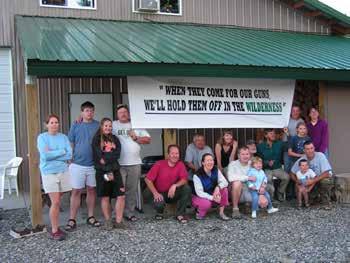
spread in Boise due to Larry, and soon stalwarts like Sean Carrier and Jeff Barney showed up to help. Meanwhile, Barry Whitehill was talking BHA up in Alaska, and David Lyon of Homer joined him to help guide that potential chapter. Luckily, Barry hunted each September in Idaho with a cohort of friends from Washington, so quickly those seeds were planted as well. Soon, Joe Mirasole of Spokane joined BHA and worked hard to add more members. His first recruit was his dad, Bob, who also spread the word. In Utah, Dan Hines and his wife Karen Boeger led the charge that ignited that state chapter. And after Dan’s untimely passing, Karen has been a BHA mainstay for the past 20 years.
At first, telling our story was tough. With just a newsletter printed off by Mike Beagle and stapled by his kids – the first Backcountry Journals – to spread the gospel of BHA, we clearly needed money for outreach.
Making cold calls to foundations to tell the story about our unique position, Mike landed our first grant. We used the money to hire a director and one support/office person at astonishingly low salaries. Our first office was in Joseph, Oregon, a place flush with hunters but no access to airports or other forms of outreach. Mike and I continued approaching foundations, most of which were already supporting other, larger conservation groups. But we kept telling our story and assuring funders we were unique – that hunters and anglers were hungry for what BHA could offer and that their investment was a way to protect public lands and waters with a voice never heard before. Sometimes the sales pitch produced nothing, but over the first and second years, more foundations saw BHA’s potential and agreed to fund us.
The second year BHA had funding was rough. Our executive director left for other opportunities, and we only had two staff people: Rose Caslar in Joseph, Oregon, as our bookkeeper and me as conservation director and interim executive director. But with foundation money, we added our first outreach employee, hiring Tim Brass to help guide a chapter in Colorado. We were looking shaky, but the BHA board was a huge support, offering advice and
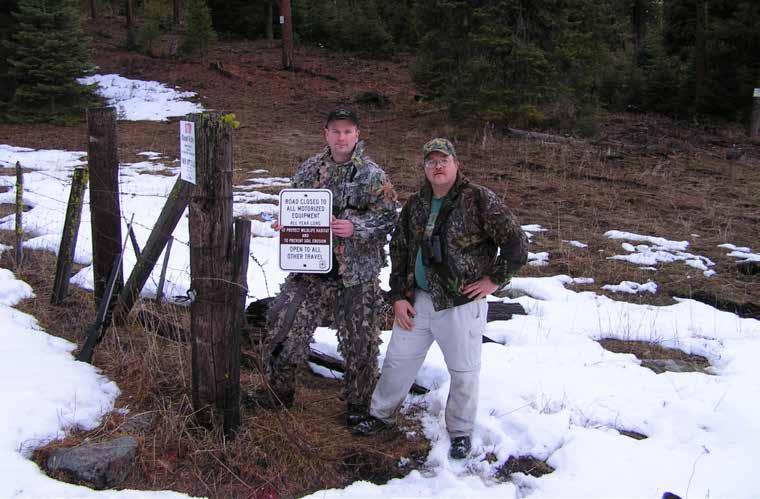
From a tiny staff in a unique but struggling organization, BHA began its amazing growth reaching far beyond what the small group of us at the beginning imagined was possible.
encouragement. We simply refused to fail. We told our funders that although we were small, we had passionate members working diligently as volunteers to engage in state and national issues to be sure our voice for conservation was heard. In Idaho, our members were showing up to provide input on the Idaho Roadless Rule, where we had a significant impact at hearings around the state.
During this time, Bill Hanlon of British Columbia contacted me and said he and others wanted to start a chapter. “Great!” I thought. “Now, how the heck do we do that?”
Bill and several friends got on the phone with me one night, and the energy to begin a BHA chapter in Canada was intense; these guys wanted to get this done! So with abundant optimism, we gave it a shot, and those Canadians made it happen. It was that same boots-on-the-ground attitude that made Bill and his buddies successful.
Then, after a year of struggle to keep BHA afloat and with new funding from foundations, the board held numerous interviews with people from national conservation groups who wanted to be a part of what BHA offered – that unique voice not for species protection but for land protection that would encompass native
species in the process. At the end of several meetings, Land Tawney interviewed in Missoula, and with his conservation experience and dedication to public land hunting and fishing, we felt there was a solid reason to hope that BHA could grow and begin to roar instead of whisper.
From a tiny staff in a unique but struggling organization, BHA began its amazing growth reaching far beyond what the small group of us at the beginning imagined was possible. It has literally been a dream come true.
Holly Endersby had a career in education as a principal before moving on to being an award-winning freelance outdoor writer for 25 years. She was BHA’s first conservation director and served as interim executive director.
Editor’s note: Enjoy a look back at 20 years of BHA on the next spread (pages 8,9).
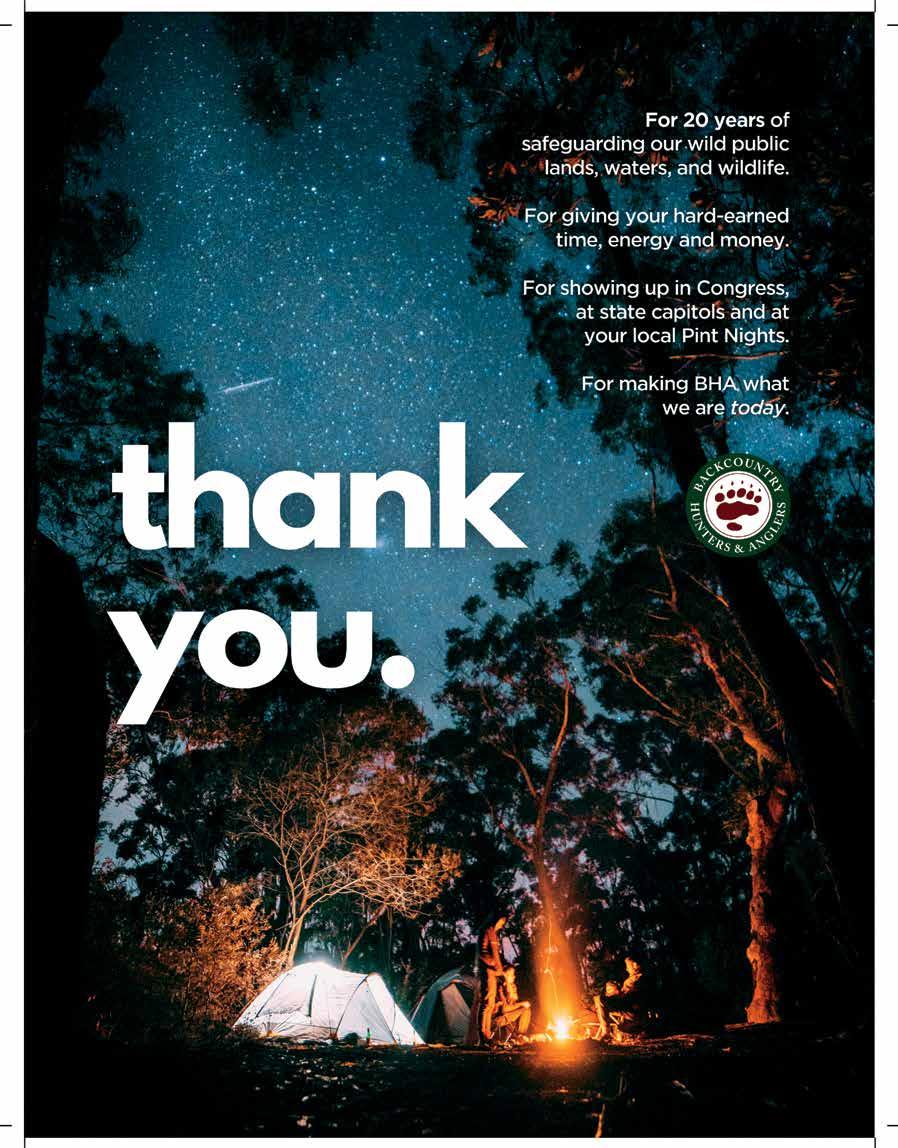
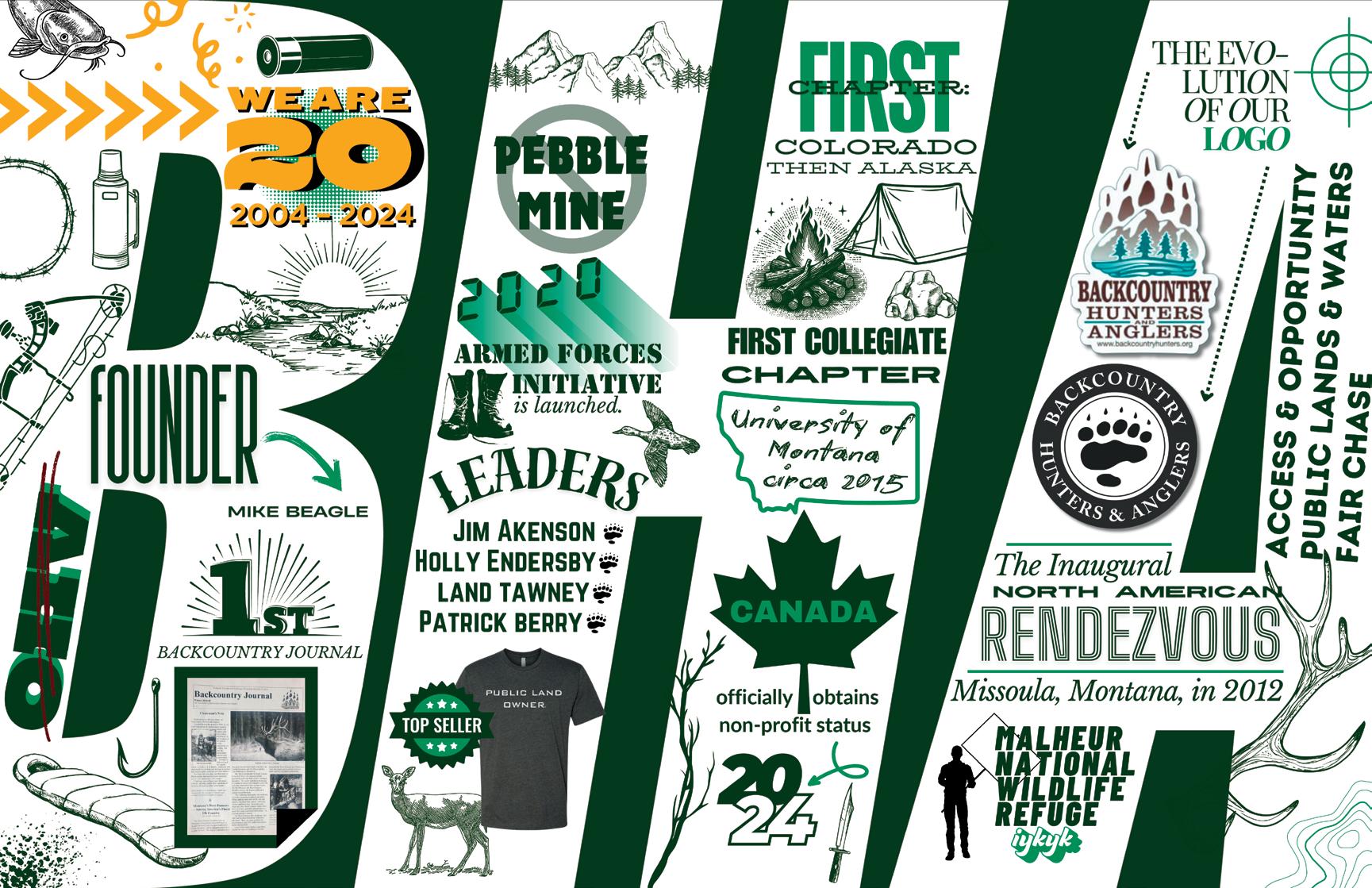

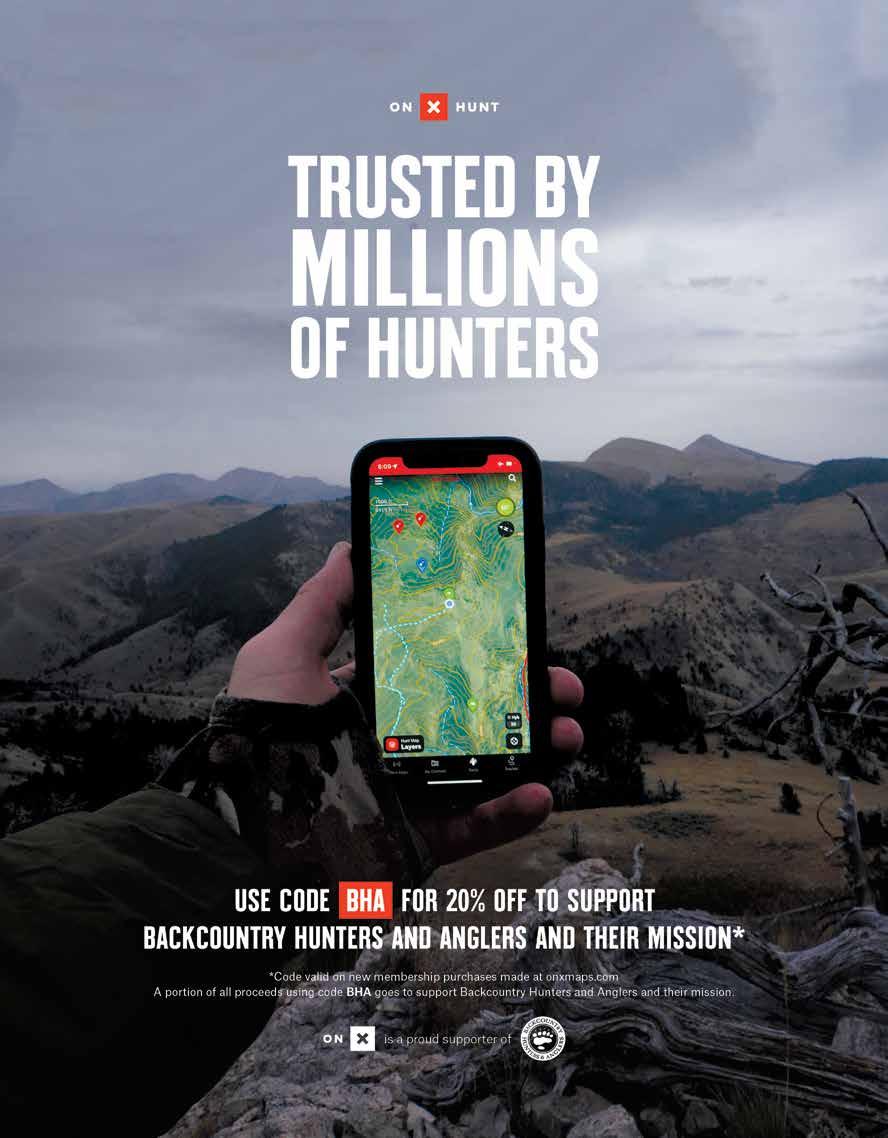
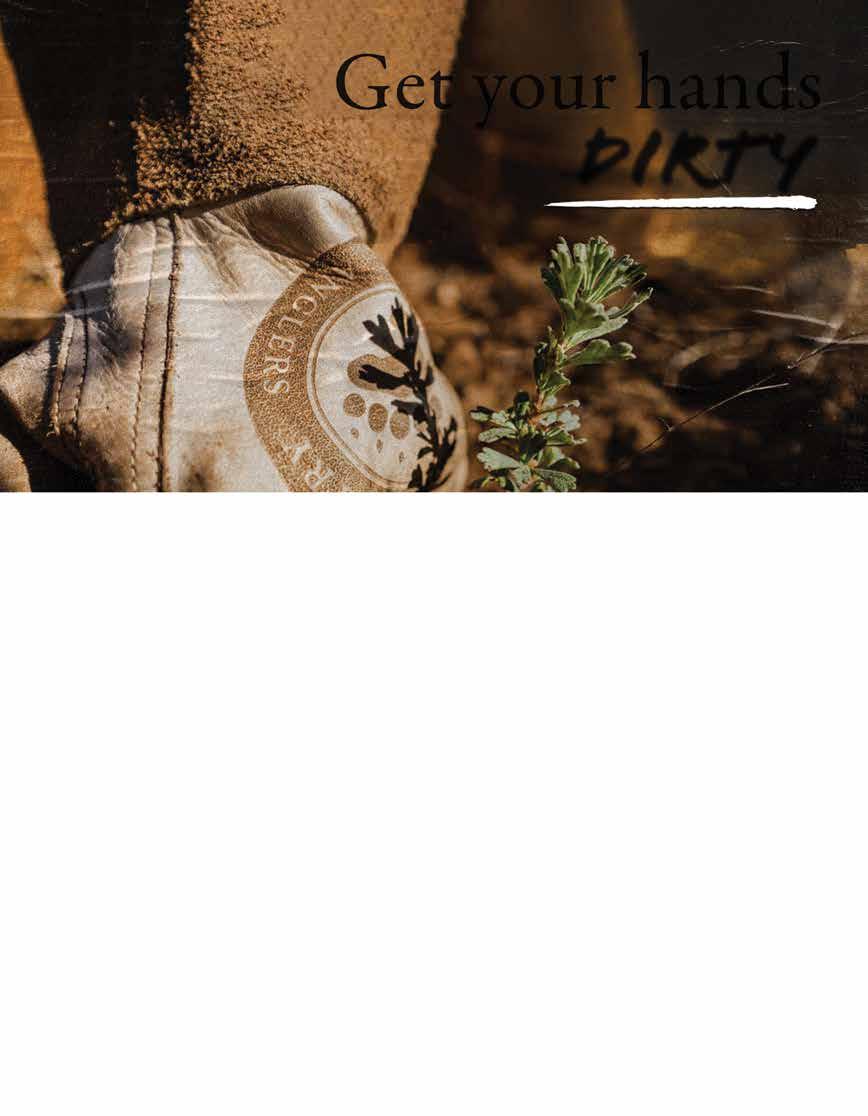










BY JESSE C. McENTEE
For about a half dozen years prior to that winter, I had been going to a friend’s deer camp that was located adjacent to what I now appreciate is some of the best big woods hunting in Vermont. The camp is old-school: no plumbing, wood heat, holes in the floor, walls filled with tinfoil and rim joists insulated with newspaper dated circa 1975. It includes a 12-inch square of scrap plywood hanging on an interior wall that lists all the deer harvested over the years; the dates go back to the 60s and end in the mid-80s. Since then, people have hunted there, but no one’s harvested anything, and the place had acquired a reputation for being unproductive. My experience back then confirmed that sentiment, but the vastness of the big woods was irresistible; it was possible to roam for days and never worry about seeing “posted” signs or a new subdivision replacing a mature hardwood stand.
Early on my hunting approach was naïve; the interest was there, but I had no guidance other than the jumble of information and advertisements found in social media and hunting magazines. I’d head into the woods, bump a couple of deer, and inevitably come home empty-handed. Something changed in 2016 when my desire to successfully harvest a deer intensified. Gravitating toward a style
of hunting that allowed me to keep moving, I found a couple people who grew up hunting and learned from them.
Opening day of the Vermont muzzleloader season is always on a Saturday in December. With odds and ends wrapped up on the home front, I threw my hunting clothes into a cardboard box with some leaves and freshly cut spruce boughs for scent control. My Buckstalker muzzleloader, a couple armloads of firewood and a cooler filled with groceries filled the trunk of my Subaru Outback. That night at camp, big wet snowflakes were sticking to the ground and the next morning there was a thin layer of snow and relatively mild temperatures – hovering around freezing.
Camp borders the Green Mountain National Forest, which encompasses over 400,000 acres in central and southern Vermont, representing the largest swath of public land in the state. Typically, I’d stay close to camp, still hunting, creeping along, hoping to sneak up on (or cross paths with) a deer. That morning the snow on Route 100 was melted but the dirt roads had a fresh coat on them. It was still dark and before shooting hours when I started looking for a track crossing the road. This area is actively managed forest; it’s predominantly northern hardwoods and some softwoods (red spruce and hemlock) with a wide-variety of management techniques employed. This has resulted in everything from early

You have to clear your mind of all of that noise and worry and focus on one thing – catching up with the buck and killing him. If you’re worried about your job, your spouse, money, the newest iPhone or if your car’s going to start while in pursuit, then the buck has won.

successional habitat filled with brambles to mature maple, beech and oak stands, which provide abundant mast crops for wildlife. All of this is adjacent to the steep, rocky ridges of the Green Mountains, distinguished by subalpine krummholz. This alpine zone runs north-south throughout the entire state and is part of the northern section of the Appalachian Mountain Range, the highest peaks reaching upwards of 4,000 feet. Mountain summits are exposed and windblown, containing only vegetation that manages to grip the metamorphic rock – in this case, stunted conifers and a few other delicate alpine plant species.
There are eight congressionally designated wilderness areas contained in the Green Mountain National Forest – of 803 wilderness areas throughout all of the U.S., which total nearly 112 million acres. Established by the Wilderness Act of 1964, these areas are designated to maintain the wilderness character, allowing only human-powered activities and prohibiting the use of motorized equipment as well as mechanical transport (e.g., ATVs, bicycles, game carts, etc.). Incidentally, I would find myself in one by the end of the day.
After about 90 minutes of driving searching for tracks, legal hunting hours had started and I was antsy. This is silly. All I’m doing is driving – I’m not even in the woods. I just need to get out there. Parking at a trailhead, I walked into a hemlock stand – at the very least I’d get a nice hike in.
In discussing whitetail tracking with other hunters, I always wondered how we were supposed to ever catch up with a deer if we’re constantly just creeping along, moving so slowly as to never make a peep. It just seemed too damn slow. Sure, you may encounter another deer by chance, but catching up with the one you’re tracking
seems impossible when moving so ploddingly.
There had to be another way.
A more aggressive approach exists. Once you get on a track you’re confident is a buck, you get after it quickly, ignoring the noises you might make. A stick cracks under foot, a branch scrapes the ripstop nylon of your backpack – ignore it. Just go. You may bump the deer, but eventually he’s going to make a mistake and if you’re focused, you’ll be there for it. This is the style of whitetail hunting I adopted that morning. Influenced by Larry Benoit’s deer hunting books, I was a minimalist: a plaid green wool shirt, wool pants and sturdy leather boots. I carried all of my ammo, food, compass and map in my pockets or belt.
After about 20 minutes I spotted an old track, halfway filled with snow and headed south. Following this track was surely better than driving around all morning in my Subaru. I trailed the track uphill for about an hour until it crossed another set of large, fresh deer prints. This new track was the type of print that makes a hunter’s heart skip a beat. Even back then with less experience, I knew it was a track to follow: large hoof, wide stance, solitary. The spruce trees were becoming white, their branches heavy with snow. The walking was quiet. The pursuit was on.
Move quickly; don’t worry about the noise. My eyes scanned ahead, looking for the horizontal line of a deer’s back, a nose, set of eyes, a tail flicker, a leg. A flash 20 yards ahead caught my eye. It had been bedded. The bed itself was large, and the buck’s body heat had melted most of the snow down to leaves. Tarsal gland stains were evident in the remaining snow. It had bounded from its bed and continued to run for a couple hundred yards, eventually returning to a walk, heading steadily uphill.
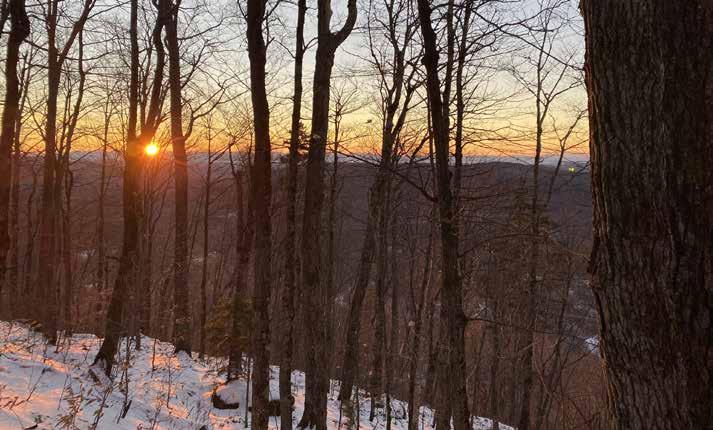
While I had been after the deer for a couple of hours, fatigue had started pursuing me. I chose not to bring water on my hunts back then since it was heavy, and I thought it would slow me down. My peanut butter and jelly sandwich was long gone. Two hours-worth of melted snow on my wool shirt made the wind seem stronger and colder than it actually was. A psychological barrier emerged: doubt. How long should I follow this track? What time should I leave it to get back the car? How will I get the deer out if I shoot it? Do I feel like hiking back to my rig in the dark?
This uncertainty needed to be extinguished. It was helpful to remember the advice big-woods deer-tracking legend Larry Benoit gives in his book How to Bag the Biggest Buck of Your Life. It’s a bit of Zen philosophy where he talks about not letting these voices takeover when you’re in pursuit of a buck. You have to clear your mind of all of that noise and worry and focus on one thing –catching up with the buck and killing him. If you’re worried about your job, your spouse, money, the newest iPhone or if your car’s going to start while in pursuit, then the buck has won.
This philosophy has even more relevance today. The distractions of Larry Benoit’s time still exist, but now we have the supercomputers in our pockets where a hunter can check the map, the weather or emails. Luckily, cell service was nonexistent in the wilderness area the buck and I had just entered.
Clear mind, no distractions. No kids to pick up off the bus; no early bedtime for work the next day. Chase this buck for the next eight hours, up and down over ridges, through streams, up to the top of the mountain. Wilderness. Freedom. After a while, the deer started acting funny. Run then walk. Jump to the side. Walk back on its own track. It knew something was after it. Predator after prey.
I trudged after the deer, deeper into the wilderness area, climbing higher and higher, wind in my face. Eventually I looked up a steep incline, and there he was – only 25 yards away, standing with his head down behind a fallen tree. I switched the safety off and waited for him to lift his head so I could confirm antlers. And then I pulled the trigger.
Sprinting up through the smoke to where the deer had been, there were dark red spots on the snow. Good, there’s blood. Contact. And then there he was, laying down, looking at me from only five feet away. We locked eyes for about a second, then he got up and stumbled down the mountain crashing through hobblebush. Adrenalin pumping, I ran after the injured buck and found him sitting up, looking at me. I reloaded and finished him off with another shot into the vitals.
A classic Vermont ridge-runner, I stared at him, my hand on his body, feeling the heat escape his thick fur. Our body heat melted the snow landing on our backs. Truly alone and at peace in the moment, nothing else mattered. It was primal and raw. My mind went to a new place, a wilder place. Hyper-focused on the buck and the immediate surroundings, the noise of the modern world had disappeared. Unfinished chores and unanswered texts all faded into the background. There was plenty to figure out, but none of it mattered. It was me on the mountain, in the woods, with the buck, high from the kill. The smell of the muzzleloader shot lingered. His hair stuck to my sweaty, cold hands. The only sound was the wind. Bliss.
After gutting the deer, I tied one end of paracord to his antlers and the other to a stout stick and began to drag him out. When tired, I’d rest by sitting on his shoulders. When my hands got too
numb to grip the drag stick, I’d warm them on his ribcage.
Eventually, a couple of my buddies and I connected, and I had some help with the last bit of the drag. “Where are you?” they asked.
“I don’t know – uphill from that road.” I knew I’d get back eventually following the old philosophy of Northeast hunters: Go downhill to a stream, then follow that to a road or town.
What seemed impossible finally happened after eight years of getting skunked. I was thrilled, but it wasn’t the feeling I expected. Perhaps I had expected to be hunting with a friend when I shot my first deer, and we’d be congratulating each other, high-fiving like they do in hunting-gear advertisements. Or maybe I’d be shouting and pumping my fist in the air. Instead, the experience there deep in the backcountry started a new life chapter, seeking out experiences involving struggle, wilderness and solitude.
I hung up the deer back at camp, and we added my name to the scrap plywood piece hanging on the wall. I don’t think I took my eyes off that deer for more than a half hour that night. I would get up, turn on the spotlight and look out the window to make sure he was still there – and that it all was real.
BHA member Jesse C. McEntee is a writer from Vermont. His work explores pressing issues related to wilderness through the prism of hunting and fishing. You can learn more about his work at jessemcentee.com


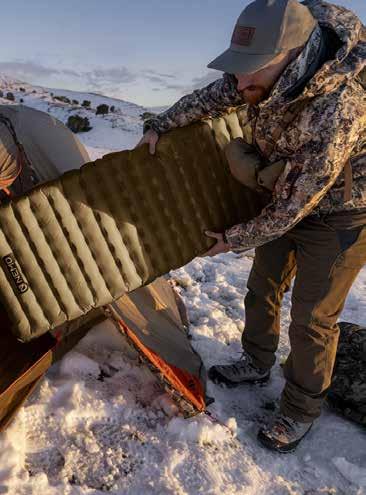
























































































































































Delivering unmatched accuracy and weighing in at 24 ounces, the Alpine™ CT features an ultra lightweight carbon fiber Peak 44™ Bastion stock and tensioned carbon fiber BSF barrel. Built on Weatherby®’s newest bolt action platform, the Model 307 ™, and proudly manufactured in Sheridan, WY.



























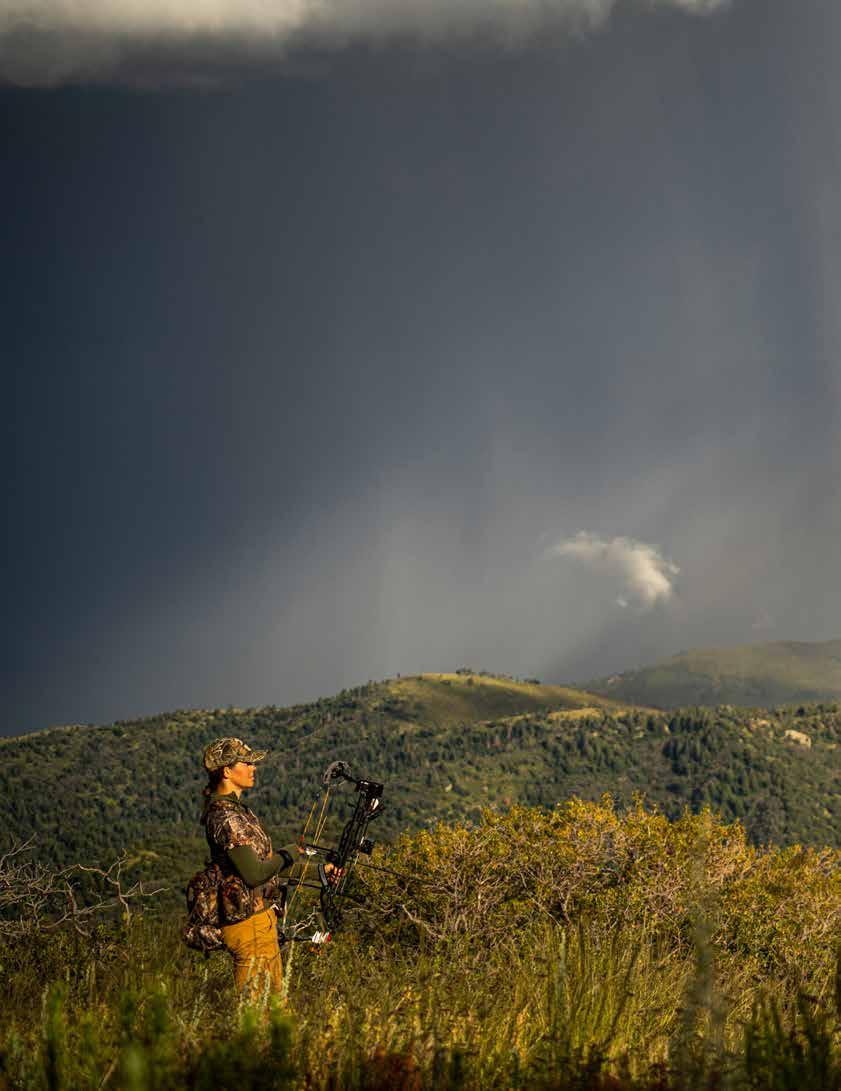


A long-standing grudge against federal public lands – lands intended to be accessible by and for all Americans – has resulted in Utah officials attempting to remove from the public domain one of the crown jewels of North American conservation: our public lands. Utah officials are seeking control of “unappropriated” Bureau of Land Management territory, a profound misstep in the ideology of public land management and stewardship of natural resources in Utah. The proposed transfer of federal lands to state control also raises grave concerns about the potential for increased commercial exploitation, increased costs to state budgets, diminished conservation efforts, and restricted public access. BHA stands firmly in opposition to this political maneuver, which directly attacks the shared heritage of public lands and waters that provide hunting and angling opportunities for sportsmen and women.
“Americans who love to hunt, fish and enjoy the outdoors rely on public lands across this country as a place where they can pursue their passions and pass down our outdoor heritage from generation to generation,” said BHA President & CEO Patrick Berry. “An attempted land grab by the state of Utah of assets owned by all Americans is a shameful, short-sighted way to make political points. Public lands are the national treasure that support our way
of life, conserve wildlife and provide recreational opportunities for everyone. Allowing state control would risk the integrity of these lands, ultimately leading towards privatization and exclusion for all but those with the deepest pockets.”
This attack follows in the footsteps of Rep. Jason Chaffetz (RUT) who withdrew legislation in 2017, following an outpouring from BHA’s grassroots advocates and sportsmen and women nationwide, that would have divested public lands from the American public. BHA has long stood in staunch opposition to legislators and lobbyists who have tried to wrest control of these lands from federal hands; that’s why the Utah chapter of BHA is, once again, pushing back against this ill-advised proposal.
“While our state government claims it is committed to keeping public lands in public hands, the only guarantee that comes from such a transfer is the removal of these existing federal protections and increased exposure to privatization,” said Caitlin Curry, vice chair for the Utah chapter of BHA.
BHA has mounted a full-scale opposition campaign to ensure your voice is heard in this attack against all of OUR wild public lands, waters, and wildlife.
Learn more and get involved at www.utahisnotforsale.org


The Wilderness Act was passed by Congress in 1964, and has since protected over 109 million acres of American public lands. But the idea was born in 1924, with the vision of none other than Aldo Leopold, who was then supervisor of the Carson National Forest, and had spent almost 15 years working on and exploring the wild public lands of New Mexico. Leopold argued that among the resources the Forest Service was mandated to safeguard for the American people were open spaces for hunting, fishing and real adventure. He argued, eloquently, that these values existed in abundance on the unpeopled lands of the Gila National Forest, that they were becoming more and more rare across North America, and that the U.S. Forest Service could choose to protect them for future generations.
Celebrate Aldo Leopold, 100 years of the Gila Wilderness and 60 years of the Wildernss Act with Episode 185 of the Podcast & Blast.
And don’t miss the amazing story of Alone Winner Woniya Thibeault, and Gaspar Perricone discussing ballot box biology and Colorado’s proposed mountain lion hunting ban. Those and so much more on the Backcountry Hunters & Anglers Podcast & Blast with host Hal Herring, wherever you get your podcasts.
All Americans have a right to enjoy our public lands and waters – but no user group has a right to damage shared public treasures or ruin the experience of others enjoying the great outdoors. Most of us can tell stories of stalks ruined, peace and quiet shattered and wildlife spooked by illegal off-road driving.

To help encourage sportsmen and public land users to continue our longstanding tradition of policing our own ranks, BHA offers a reward of up to $500 for reports or information leading to a citation for illegal motorized use. Report illegal off-road use to your local game warden and/or land manager and help ensure that we continue to have quality habitat, hunts and access for all.
For more information on claiming a reward, visit backcountryhunters.org/ohv_and_illegal_motorized_use_program. You can still support the program, even if you don’t claim a reward: Donate to the reward fund and help safeguard our public lands habitat. And did you know: We offer a reward for those curtailing illegal dumping, too?
Taking pictures of our backcountry experiences is just one way hunters and anglers capture our most beloved memories in designated wilderness, on Bureau of Land Management tracts, U.S. Forest Service parcels, and on public waters in between. And we want to see your pics!

Backcountry Hunters & Anglers is launching our 2024 Public Lands and Waters Photo Contest with some changes to the previous format. This year we are offering three categories (Hunting on Public Lands, Fishing on Public Waters, and Backcountry Wildlife) and the winners for each category will be chosen by BHA’s marketing and communications staff. Our prize packages are also the biggest we’ve ever had, with over $4,000 in gear and credit from partners: Stone Glacier, Weston, Sitka, Sage, Seek Outside, Benchmade and Dometic!
Also new this year is a members-only category in celebration of BHA’s 20th anniversary! Share your best photos from past BHA events, including: hunting camps, fishing trips, advocacy efforts, habitat stewardship, and any other place where members have made their mark!
Along with that stellar prize package will be a photo feature in our Backcountry Journal’s summer 2025 edition and a journal cover for the overall winner of the photo contest. Enter by Nov. 30, 2024, at backcountryhunters.org/ the_2024_public_lands_and_waters_photo_contest
BHA’s one-of-a-kind annual gathering of public lands and waters enthusiasts will take place June 13-15, 2025. Join us to share stories with your community, chat with vendors and get your hands on the latest gear, and learn about the latest hunting, fishing, foraging and conservation techniques. Mark your calendars and look for a location announcement coming in November. We look forward to seeing you there!



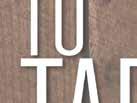
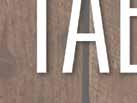





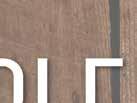



















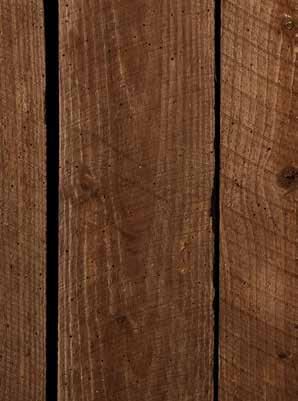




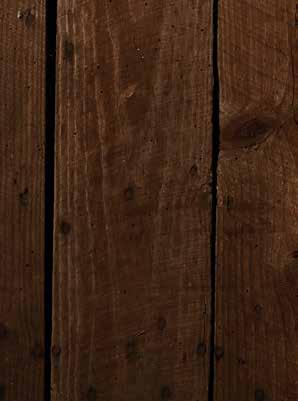
FOR THOSE UNFAMILIAR WITH YOUR HOME REGION, WHAT DO YOU FIND SO SPECIAL ABOUT EASTERN NEVADA?
This part of Nevada has some of the best hunting in the state for both upland and big game. My first two successful mule deer hunts were in what would be lost in the Winecup Gamble exchange (see below). The diversity of the area in topography, remoteness, weather and low human population makes it desirable. It’s not difficult to venture around the northern edge of the Great Basin and have it to yourself for several days. I’ve spent the last 30-some years enjoying the history, wildlife, geology and culture that this part of Nevada has to offer.
Nevada Chapter Board Member

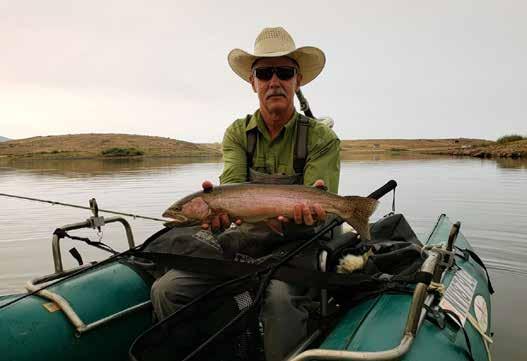
YOU SOUNDED THE ALARM IN NEVADA ON THE POTENTIAL WINECUP GAMBLE LAND EXCHANGE, WHICH WOULD TRANSFER 235,000 ACRES OF BLM LAND IN EXCHANGE FOR 85,000 ACRES OF PRIVATE RANCH AND COULD HAVE RESULTED IN A LARGESCALE LOSS OF PUBLIC LAND ACCESS (ALONG WITH NUMEROUS OTHER POTENTIAL ISSUES) AND THE LOSS OF SOME OF THE BEST MULE DEER HUNTING IN THE REGION. HOW DID YOU FIND OUT ABOUT THE ISSUE? AND WHAT INSPIRED YOU TO TAKE ACTION?
First of all, I was not alone in this endeavor. There were members from a slew of entities concerned about this proposal. When we first heard of the proposal, information was scarce and what was known was first thought to be rumors. The more we dug through public-records requests, talked to employees of the state and federal agencies involved and asked the right questions, the more concerned we became; what we thought first were rumors turned out to be facts. So, we sat down, researched and obtained information about those involved and compiled our information. I then volunteered to contact the NGOs who were reportedly informed by Winecup Gamble, along with what we thought were the proper NGOs to help start digging deeper into this. That led me to BHA and BHA Chapter Coordinator Dre Arman. She showed interest in this and kept in contact with me exchanging information as it came up. This issue needed to be addressed quickly, and what information we had needed to be shared with the public. We also needed to make sure that those tied to the WG land swap proposal were aware that we as public land users were not happy with their ideas. Every time there was a chance to voice our opinion, we were there, voicing it.
We got our point across, which made the WG folks backtrack for the time being. But I know this issue is not over.
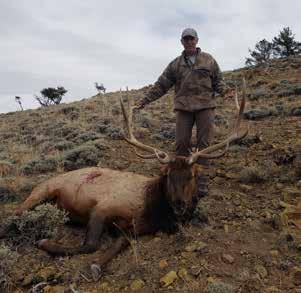
WHAT IS MOTIVATING YOU IN YOUR WORK WITH BHA?
All the motivation I need is to know where I can go may someday be lost, and to also know what the country used to look like prior to poor land use and management practices.
WHAT ADVICE WOULD YOU GIVE OTHER BHA MEMBERS IN STAYING VIGILANT AND SAFEGUARDING THEIR LOCAL PUBLIC LANDS, WATERS AND WILDLIFE?
If you care, get involved.
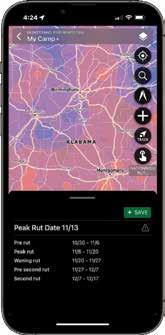
WHITETAIL RUT MAP Unlock the most extensive Rut Map in the country

WHITETAIL ACTIVITY FORECAST Plan your hunt around peak movement times
Join millions of hunters who use HuntStand to view property lines, find public hunting land, and manage their hunting property. Enjoy a powerful collection of maps and tools — including nationwide rut dates and a 7-day whitetail activity forecast with peak deer movement times.

WHITETAIL

Download and map for FREE!










BHA’s Backcountry Bounty is a celebration not of antler size but of BHA’s values: wild places, hard work, fair chase and wild-harvested food. Send your submissions to williams@backcountryhunters.org or share your photos with us by using #backcountryhuntersandanglers on social media! Emailed bounty submissions may also appear on social media.
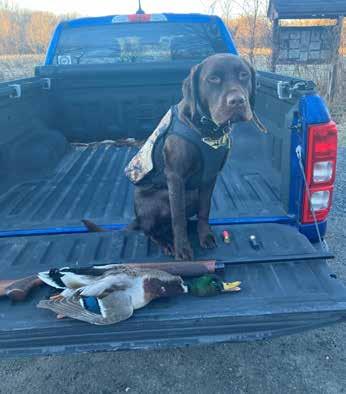
Hunter: Josh Westlund, BHA life member, and Huey (first retrieve!) | Species: mallard | State: Maryland | Method: shotgun | Distance from nearest road: two miles
Transportation: foot
Angler: Will Barry (12), BHA life member | Species: lake trout State: New York | Method: spinning | Distance from nearest road: 7 miles | Transportation: packraft/foot
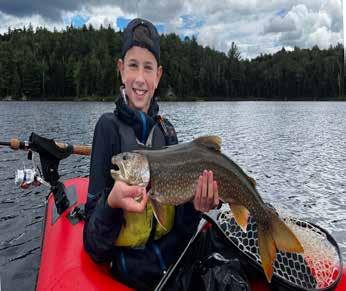
Hunter: John Perdaems | Species: bison | State: Montana Method: rifle | Distance from nearest road: 30 miles
Transportation: horseback


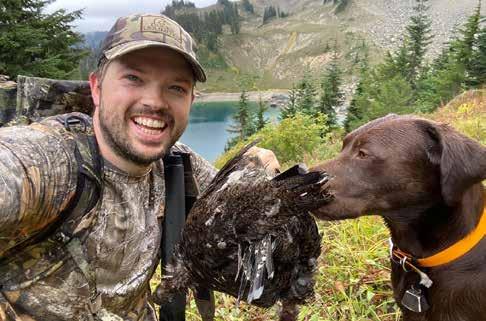
Hunter: Tucker Jensen, BHA member, and Tsuga | Species: blue grouse | State: Washington Method: shotgun | Distance from nearest road: one mile
Transportation: foot

Hunter: Hunter Goodwin, BHA member | Species: whitetail State: Arkansas | Method: rifle Distance from nearest road: two miles | Transportation: foot

Hunter: Jeff Lewis, BHA life member | Species: cougar State: Oregon | Method: rifle | Distance from nearest road: one mile | Transportation: foot



BY RON ROHRBAUGH
Before the sun had fully broken the eastern horizon, Pony could hear the bull – her bull – grunting and splashing in a wallow below her. As shafts of warm yellow light revealed the prairie’s details, Pony could see the bull’s outline. He was looking west toward a herd of cows, grazing on a hilltop ablaze with colorful wildflowers. Pony couldn’t let the bull go to the distant herd or he’d surely slip away. Her pulse quickened as she knew what had to come next.
Pony pulled a small buffalo hide over her body in hopes of tricking the old bull into thinking she was a young challenger. She paused a minute, thinking what a foolish idea this was, before getting up her nerve to crawl from the cover of the sand plums into the wide-open prairie. There was no going back now. Amazingly, the rut-crazed bull remained fixed on the herd of cows, completely unaware of Pony.
Closer and closer she crawled, her heart hammering as she closed the distance to just 50 yards, not knowing exactly what would happen but certain this was her destiny. Pony grunted in her best imitation of a young bull buffalo that was trying to horn in on the old bull’s herd of cows. There was no response from the bull. Pony waited a few seconds and grunted a second time. This time, she saw the bull’s ears swivel. He had clearly heard her but did not turn to look. Again, Pony waited.
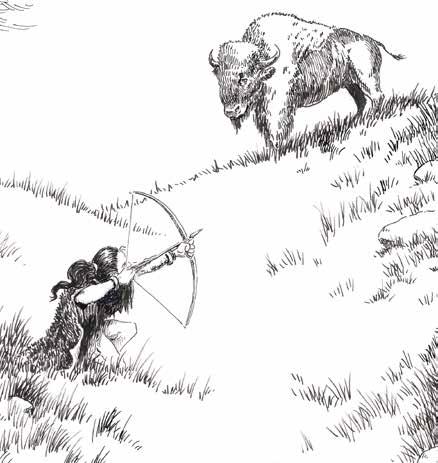
at full draw. The arrow sped toward the bull’s chest as if it was guided by the pure will of her ancestors.
The third grunt took more courage than the first two. The bull knew she was there. What would he do if she challenged him again? She glanced at her bow to be sure an arrow was nocked and ready. She put her right hand to Echo’s neck knife and let out a long, aggressive grunt. Ooooo-ahhh!
The bull spun his 1,800-pound bulk with remarkable speed and began walking to Pony. He swung his enormous head from side to side, moving in an odd sideways walk meant to make him look even bigger. Pony moved too, pivoting to keep the bull broadside to her. She could not shoot the bull if it was facing her.
At 30 yards, the bull thrust his enormous head upward, pulling great quantities of air into his oversized nostrils. He was testing for danger. Hidden beneath her hide, Pony shook like a scared dog, waiting for what might come next. But the bull could not detect her human scent. Heated air from the rising sun pulled Pony’s smell up and away from the enraged animal.
He kept coming in his sideways walk ... 25 yards, 20 yards, 15 yards. At 10 yards, Pony could see rage in the bull’s eyes and smell the pungent urine coating his underbelly. At this range, if he charged, Pony would stand no chance of jumping out of the way. She’d be dead, and that’s all there was to it.
Eons of her people’s sorrow, guts and grit filled her hunter’s heart, giving Pony the courage for what must be done. “For those who came before,” Pony whispered to herself as she threw the hide from her back and rose to one knee with her buffalo bow already
There was a blur of brown hide and a sound like tearing canvas, as the bull spun, thundering over the prairie straight into the rising sun, where he vanished as if he had never been there.
Breathing hard, Pony dropped to her hands and knees to pull herself together. She sat on the prairie, allowing the sun to wash over her for as long as she could wait, which was not very long. She had to know. Did her shot end a 150-year-old struggle for tribal redemption or had she failed them again?
BHA member Ron Rohrbaugh is a professional conservation scientist and award-winning author. His recent works include LIVING WILD, an adventure/historical fiction series for kids and Tine to Table, a collection of essays and recipes. Ron’s book Echo was recently named Book of the Year by Children’s Book International. Ron travels the country full-time in an RV with his family, where he’s on a mission to help save wild places, share wild food and be every child’s gateway to nature. You can follow their adventures on Facebook, YouTube, and Instagram @ The Living Wild Family.
This story was excerpted from chapter 38 of The Last Prairie, which is book two in the award-winning LIVING WILD with the Orions series, appropriate for kids ages 8-14 and up. In The Last Prairie, 12-year-old woodsman Echo Orion and Pony Proudchief find themselves in the middle of a 150-year battle that began when market hunters destroyed the bison that was the Native American’s lifeblood. As Pony’s Osage Tribe seeks to recover a piece of their lost world, they must battle a new foe that threatens their modern-day Grand Bison Hunt.
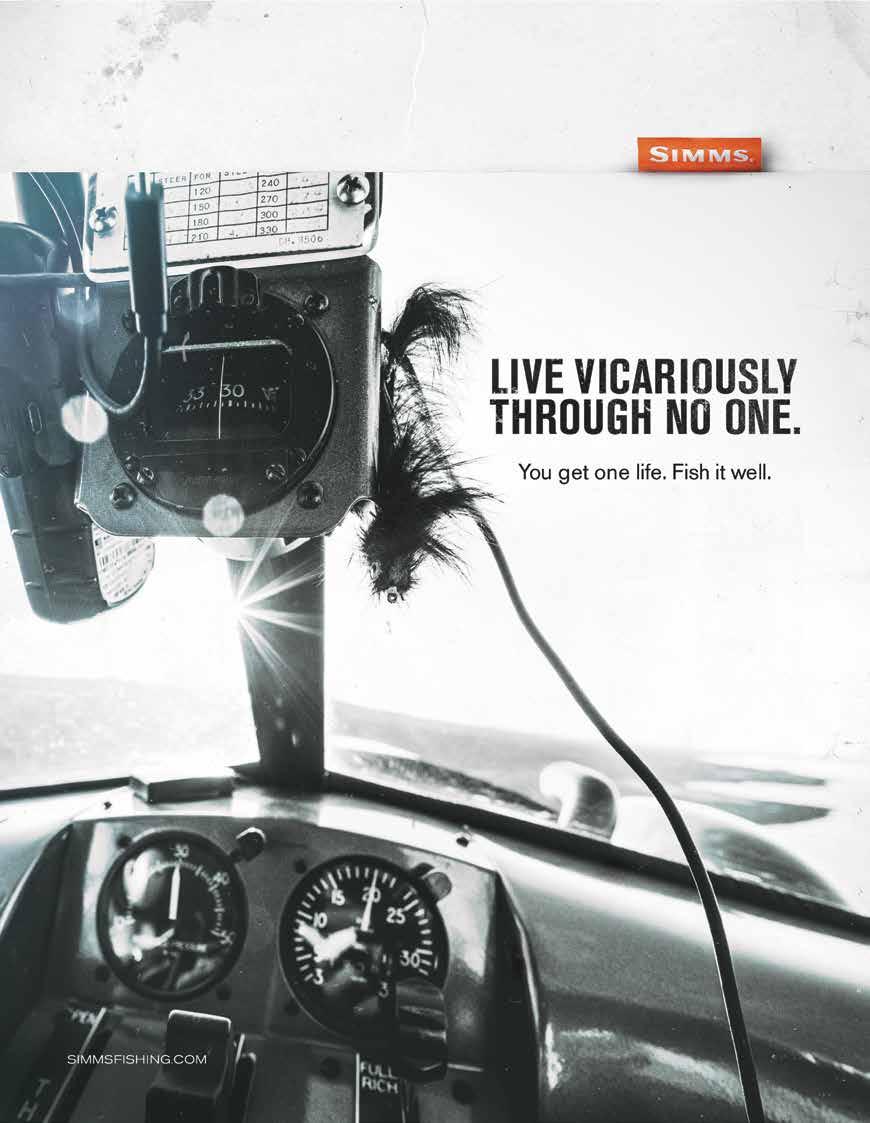
the hike. the hunt. the harvest. the adventure. the journey. the spot. the story. the meal. the catch.
the fearless
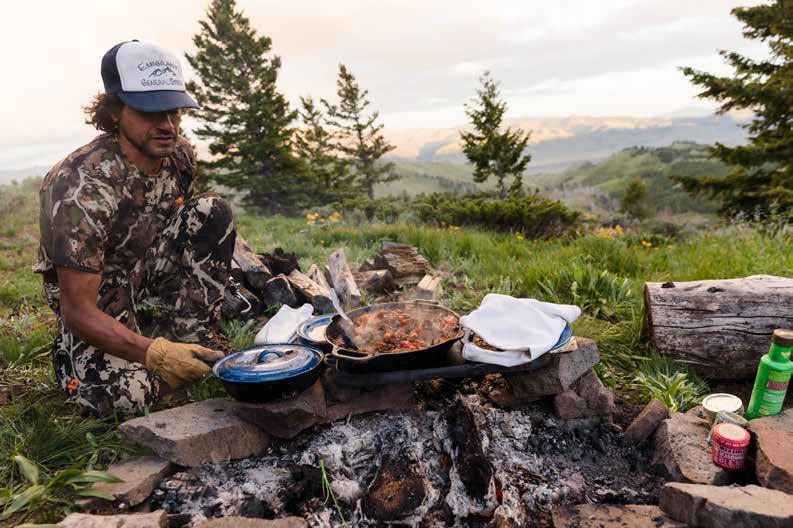
Get 10% off any order with discount code BHA10




BY BRYAN JONES
This fall the public’s right to hunt will take center stage on the ballot in Colorado with a proposed ban on hunting mountain lions, bobcats and lynx (a federally protected, non-huntable species). Not only would this hunting ban define in Colorado state statute the legal hunting of multiple wildlife species as “trophy hunting,” it would also classify “trophy hunting” as a Class 1 misdemeanor.
BHA strongly opposes Propostion 127, and our concerns extend far beyond preserving hunting traditions; they are deeply rooted in the potential dangers this ban poses to wildlife management, conservation efforts and funding, and the broader ecosystem.
For more than a century, hunters and anglers have played a pivotal role in wildlife conservation across North America, guided by the North American Model of Wildlife Conservation. This model ensures that wildlife is managed for the benefit of all citizens, a success made possible largely due to the financial contributions of hunters and anglers. Through licenses, excise taxes and other direct contributions, these efforts have been critical in supporting habitat restoration, species reintroduction and the establishment of protected areas.
BHA is deeply concerned that Colorado’s proposed hunting ban could jeopardize this proven model of wildlife conservation. The initiative, driven by public opinion and emotional appeal over scientific expertise, risks dismantling the carefully structured processes that have allowed wildlife populations to thrive. Our primary objection lies in the method of pursuing this ban through
a ballot initiative – a tool that, while democratic, can oversimplify complex issues and lead to decisions that may not align with the best available science.
Wildlife management is a specialized field that requires a deep understanding of ecological dynamics, population biology and species interactions. Decisions made by popular vote, rather than by scientific evidence, carry a significant risk of unintended and potentially harmful consequences.
Moreover, banning public hunting does not eliminate the need for population control. To prevent overpopulation and its associated issues – such as increased conflicts with humans and ecological imbalances – the government will still need to intervene. This often involves employing contract hunters for hire. Unlike public hunting, which is regulated and contributes to conservation funding, contract hunting is costly for the state, diverting resources away from other crucial conservation efforts. This could lead to misunderstandings about the effectiveness and necessity of wildlife management practices, potentially undermining public trust in the science-based methods that have been successful for decades. Contract hunting is also a waste of both opportunity and resources, including the potential waste of the meat derived from the current hunting of these animals. Colorado has strict laws governing the wanton waste of big game animals, and mountain lions are no different. Not only are the harvested animals required to be inspected by Colorado Parks & Wildlife biologists, but the meat is also required to be taken and consumed. Despite what proponents of this initiative may
state, mountain lion meat is well regarded and can be utilized in a variety of recipes.
Professional wildlife managers, trained in the complexities of ecosystems, should guide decisions about wildlife populations. These experts manage predator numbers through various scientific methods, including regulated hunting, to ensure that prey species are not over-exploited, which is crucial for maintaining the health of the entire ecosystem.
Bypassing these scientific processes in favor of public opinion could undermine decades of successful wildlife management. Without the ability to manage mountain lion populations through regulated hunting, we could see a cascade of negative effects throughout the food chain, ultimately harming the very wildlife this ban aims to protect.
It is also important to recognize the broader implications of such a ban. Economic impact assessments for this initiative predict that the state could lose an estimated $410,000 annually from mountain lion hunting license sales alone, with additional losses from bobcat hunting licenses as well. More concerning, however, is the potential cascading effect on the state’s revenue from elk and mule deer hunting due to decreasing tag allocations and potential loss of licenses fees for those prey species.
As hunters and anglers, we are not just financial contributors; we are stewards of the land and wildlife. The deep connection to the natural world gained through hunting and angling fosters a profound sense of responsibility for sustainable management. This stewardship is essential to wildlife conservation and should not be sidelined by initiatives that fail to recognize its value. While BHA supports greater public involvement in wildlife management, we believe this should occur within the existing framework, which has proven effective over time. Public input is vital, and we welcome a diverse range of voices, including nonconsumptive users, in the conversation. However, this should not come at the expense of sidelining hunters and anglers or undermining science-based management practices.
In conclusion, our opposition to the proposed Colorado mountain lion hunting ban is not about excluding the nonconsumptive public from the conversation. It is about ensuring that wildlife management decisions are based on credible science and guided by professional expertise. The risks of politicizing wildlife management through ballot initiatives are significant, and we urge that proven conservation methods not be discarded in favor of processes that oversimplify complex ecological issues.
As Coloradans consider Propostion 127, it’s crucial to recognize the dangers this ban could have on wildlife management, conservation efforts and the broader ecosystem. BHA calls for a more inclusive and informed approach to wildlife management – which respects the contributions of hunters and anglers and upholds the principles of science-based management.
Bryan Jones was born and raised in Colorado with a passion for the outdoors. He served in the U.S. Marine Corps for 10 years before earning a degree in fish and wildlife management. His experience in conservation and wildlife management was developed while serving in both public and private lands management roles, and he holds a master’s degree in natural resource stewardship from Colorado State University.
Ingredients:
Mountain Lion Carnitas Servings: 6 by Bryan
Jones
• 3 pounds mountain lion meat (from the shoulder or hind quarter works well)
• ½ pound of lard or other rendered fat
• 1 cup fresh squeezed orange juice (store bought will work)
• 3 cups water
• 4 cloves of garlic
• 1 tablespoon cumin
• 2 teaspoons kosher salt
• 1 teaspoon course ground black pepper
• Tortillas, your favorite Hatch green chile salsa, cilantro and onions for serving
Instructions:
1. Cut meat into 2-inch cubes, add to a large pot with the lard, juice, water and spices. Bring to a boil and then simmer uncovered on low for 2 hours. Do not touch the meat.
2. After 2 hours, turn heat up to medium-high and continue to cook until all the liquid has evaporated, and the fat has rendered (about 45 minutes). Stir a few times, to keep meat from sticking to bottom of pan.
3. When meat has browned on both sides, it’s ready (there will be still be liquid fat in the pan). Serve either cubed or shredded (meat will be tender enough that just touching it will cause it to fall apart) with tortillas and Hatch green chile salsa. Enjoy!



BHA members in California combine boots-on-the-ground effort with policy work to improve big-game habitat
BY DEVIN O’DEA
Alpine lakes punctuated by pines slowly shift to sagebrush steppe and grasslands on the annual, arduous migration of the Loyalton-Truckee Deer Herd. The mule deer summer along the northeastern edge of the Sierra Nevada mountains and migrate approximately 26 miles to reach their winter-range habitat along the California and Nevada border, a trip with a terminus at the deadly Highway 395 – one of California’s 12 priority barriers to wildlife movement in the state.
Unfortunately for the ungulates who rely on bitterbush to survive the snowy seasons, much of their winter-range habitat has burned in recent massive fires fueled by invasive species like cheatgrass. Formerly abundant stands of bitterbrush, sagebrush and mountain mahogany at the Hallelujah Junction Wildlife Area have been replaced by pepperweed, medusa head and cheatgrass interspersed among a few native grasses and shrubs. This native flora is critical to the health of our migratory mule deer herds, pronghorn, bighorn sheep, sage grouse, pollinators and more, and their disappearance from the landscape underscores the need to invest in restoration of the sagebrush steppe habitat, native grasslands and the ecosystem integrity of our public lands – or else face the precipitous decline of our wild, iconic wildlife in the West.
Recognizing the severity of the situation, then Department of the Interior Secretary Ryan Zinke issued Secretarial Order 3362 in 2018, “Improving Habitat Quality in Western Big-Game Winter Range and Migration Corridors,’’ a landmark commitment to conservation that was lauded by BHA and partner organizations
across the board. The order called upon state, tribal and territorial wildlife agencies to “improve habitat quality and western big game winter range and migration corridors for antelope, elk and mule deer” as well as foster “improved collaboration with states and private landowners.” Pursuant to the order, select Western states developed action plans for their migratory deer, pronghorn and elk herds, which helped to inform distribution of federal funds earmarked for conservation.
The National Fish & Wildlife Foundation’s conservation grant program is one of the ways in which SO 3362 objectives were administered, and BHA was thrilled to receive $165,000 for our ongoing Hallelujah Junction Wildlife Area Post Fire Rehabilitation and Connectivity Project. BHA is leading the project in collaboration with the Department of Fish & Wildlife, the Washoe Tribe, the Sagebrush in Prisons Project and the Wildlands Network. This large-scale rehabilitation project seeks to restore critical winter range habitat for the LTH mule deer, pronghorn and elk in the region while simultaneously incorporating many plants of cultural significance to the Washoe Tribe. In addition, the project leverages the work of Wildlands Network along 395 to study wildlife movement through existing culverts and at-grade crossings to help inform priority areas for wildlife crossing infrastructure and investments – an effort that has helped to galvanize funding for a wildlife crossing structure along Highway 395 just north of the project area.
Last fall, BHA volunteers from across California and Nevada gathered to plant thousands of bitterbrush seedlings grown by inmates at the nearby Federal Correctional Institution, Herlong, through the voluntary Sagebrush in Prison Project. This program,

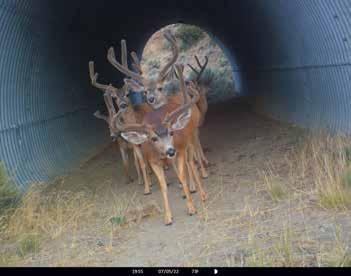
managed by the nonprofit Institute for Applied Ecology, has grown over 3.5 million sagebrush and bitterbrush plants used to restore sagebrush steppe ecosystems across the West. According to one formerly incarcerated participant in the program, “It’s really good giving back. I logged for a lot of years before I was incarcerated. So, it was a good feeling just to be back in the environment and knowing they’re going back out to help habitat and burned areas.”
This year, BHA is expecting 10,000 more bitterbrush plants from the Sagebrush in Prison Program, and volunteers will be gathering the weekend of October 25-27 for the annual Beer, Bands & Bitterbrush Stands event to help put them in the ground. This volunteer work party is followed by a real party in the evening, which includes on-site camping, live music, a wildgame potluck, raffles and more – all in an attempt to get more people to participate in the restoration project while building community and awareness of habitat loss across the Great Basin.
Later this year, BHA’s funding from the National Fish & Wildlife Foundation for this winter range rehabilitation project will be all but spent, with many millions more acres yet to be treated across the West. That’s why BHA has shared our enthusiastic support for the Wildlife Movement Through Partnerships Act, legislation introduced for the first time ever by Sen. Alex Padilla (D-CA) and Reps. Ryan Zinke (R-MT) and Don Beyer (D-VA).
The bill would build upon collaborative efforts to conserve big game migration corridors in conjunction with SO 3362 and the Wildlife Crossings Pilot Program passed within the Infrastructure Investment and Jobs Act in 2021. Promoting habitat connectivity for migratory species and improving habitat quality by providing financial and technical assistance to state and tribal fish and wildlife agencies, private landowners and nongovernmental organizations. It would also direct the Department of the Interior, Department of Agriculture and Department of Transportation to coordinate efforts with those entities. Included within these directives are the establishment of the State and Tribal Migration Research Program, to collect, research and analyze data on wildlife movement corridors, and the Wildlife Movement and Movement Area Grant Program, to improve or conserve habitat through projects including habitat leases, fence modifications, and reducing wildlife-vehicle collisions. Fifty
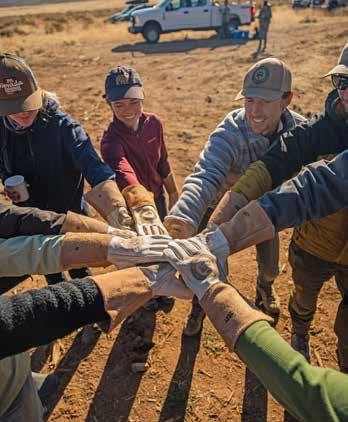
percent of funds would also be directly allocated for conserving big game species including mule deer, elk, pronghorn, moose and wild sheep, which expands the original scope of SO 3362 while still maintaining a focus on big game.
Mega-fires, biodiversity loss, climate change and partisan politics often dominate our news feeds and can be daunting and relentless. When faced with this onslaught of cynicism, we have a choice: Stick our heads in the sand and kiss our way of life goodbye – or get to work and do something about it. This October, hunters, conservationists, vegans and volunteers from three generations will be gathering under a common banner to buck the notion that there is nothing we can do to help native wildlife and to preserve our North American heritage of hunting and fishing in a natural setting. Meanwhile, we will continue to applaud our elected leaders – on both sides of the aisle – who are fighting for legislation that bolsters our efforts on the ground.
Devin O’Dea grew up abalone diving, spearfishing and backpacking in California before discovering a love for bowhunting and wing shooting. He worked for an environmental consulting firm and as a marketing manager for an archery division of Mitsubishi, but the allure of adventure, wild food and wild places led him to his current role as the western policy and conservation manager for BHA.

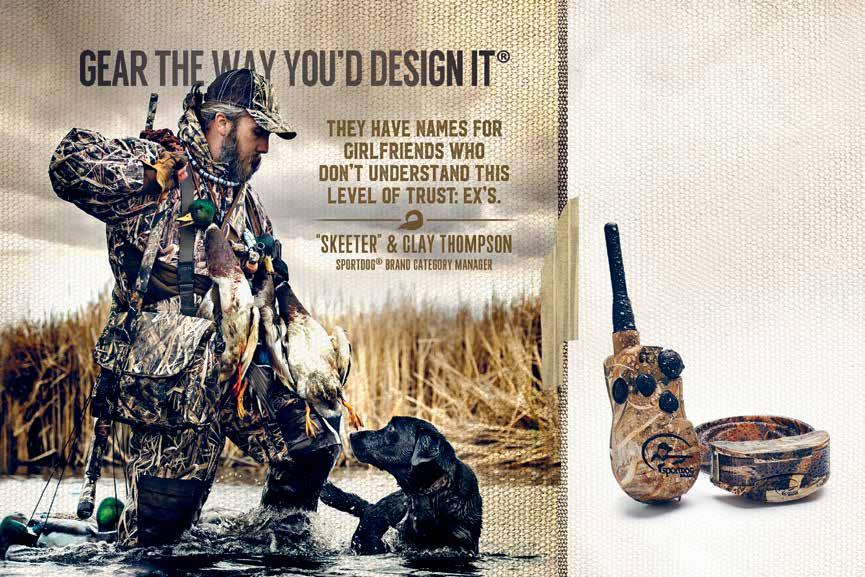

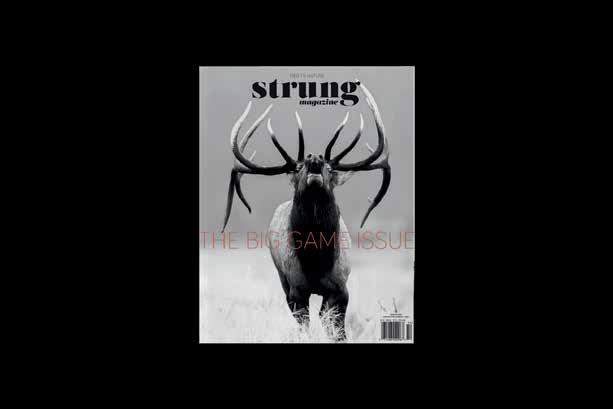


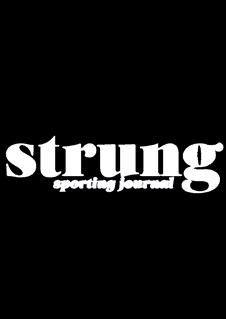



BY JAMIE CAMERON
Raise your hand if you’re a get-your-hands-dirty, give-up-yourweekend-to-volunteer, shout-from-the-mountaintop member of BHA. Keep ’em up if you scour your state chapter’s social media accounts for the next river cleanup, hunting-skills camp, pint night trivia or group campout to drive halfway across the state so you can show your support.
There’s no shortage of willing donors of blood, sweat, time and tears in this organization. It’s the bedrock of our commitment to the mission “to ensure North America’s outdoor heritage of hunting and fishing in a natural setting, through education and work on behalf of wild public lands, waters and wildlife.”
But there comes a moment in every state chapter’s vision for the future where the question needs to be answered, “How much money do we have for all this?” And for just about everyone here the answer is, “Not much.” And our work could use more; money is a valuable resource to a nonprofit organization, and the effects of every little bit more of it the organization has can be felt in both the quantity and the quality of the conservation work we do.
The North Carolina chapter has been grappling with getting the most it can with limited funding since its inception in 2018. Year after year, its dedicated members have done more with less. But there comes a time where folks start to wonder what they might accomplish if there was more in the bank account, whether it’s the chapters or BHA Headquarters.
Enter North Carolina board members Jordan Linger and Zach Brady. During the past year they’ve seemingly unlocked the secret to reliable income for their chapter’s coffers, in amounts of $300-500, on any given evening, with limited resources, anywhere in the state. Linger and Brady have tapped into the burgeoning craft brewery and distillery industry, and they’re doing it with the inescapable allure of sizzling meat and smoke. They’re flipping wild-game burgers for donations at pop-up “Smashburger” events, and they believe the model they’ve created can be adopted by BHA members anywhere in the nation.
What made you think you could do this?
Jordan: I have a background in the restaurant industry. More than that, though, I grew up in the South, and food was everything to my family. I learned to cook in my grandmother’s kitchen, fixing fried chicken on Sundays after church.

Zach: I grew up with great food and cooks in my family. My first job was washing dishes in a pizza place. When I got older, I helped my father cater events. We entered barbecue competitions with a giant smoker we trailered across North Carolina. Feeding lots of people isn’t a daunting prospect for me.
How do you avoid crossing laws against selling and trading wild fish and game meat?
Jordan: Every state is a little different I’d imagine, but in North Carolina you can stay legal if you ask for a suggested donation (we recommend $8 per burger, $12 for a double) that goes directly to a 501(c)(3) organization. Each state has a health department website that will have the particular regulations that must be followed.
How do you find your locations to host these events?
Jordan: It’s common for breweries to partner with food trucks that take care of that side of serving the customers. But it’s also common for food trucks to cancel: The truck breaks down; staff doesn’t show up; a festival comes to town and draws them elsewhere. Those cancellations put a lot of stress on breweries. You can call places and ask if they have any open dates where you can fill in. You can ask to be put on standby. Just start a relationship with the management and see where it leads.
What does food, specifically wild food, mean to you?
Zach: It’s not just sustenance. Even the simplest meals have someone behind that food. It’s showing appreciation and love for the people you’re serving. When you add wild food to the equation, it adds another layer to the story you’re trying to tell. When someone orders a venison burger at one of our events it’s often the first time they’ve ever thought about eating wild game. From the time they
place an order to the time I’m handing it to them on a plate, we’ve had four or five minutes to connect. During that interaction I can tell them about BHA and the overarching mission. People are generally curious, especially when it comes to food, and almost everyone is using public land in some form or fashion. Cooking a deer burger or a squirrel taco or ladling a bowl of Brunswick stew and handing it to someone is an open and honest invitation to have a conversation about all the things public lands provide to every American and how BHA is working to protect and enhance these places for all of us.
What You Need
• A portable flattop griddle (preferably two, one for burgers, one for buns)
• A burger press
• A dome (or two) for melting cheese
• Seasonings (salt, pepper, garlic powder)
Mise En Place
• Weigh and roll ground meat into balls (we do 1.5 ounces)
• Buns, softened butter and sliced cheese easily accessible
• Cardboard serving trays, napkins and condiments
BHA life member Jamie Cameron is a North Carolina State Parks ranger. As such, his duties include natural resources management, law enforcement, search and rescue and wildland firefighting. His passion lies in opportunities to educate young people about the outdoors and teach them to become stewards of the land.
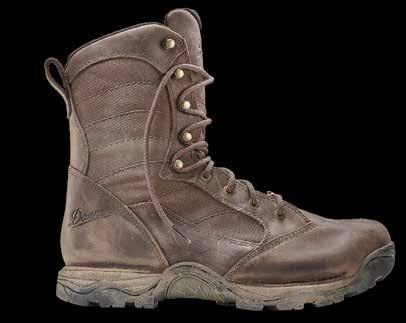

New air chamber sleeping pads made with recycled ripstop nylon.
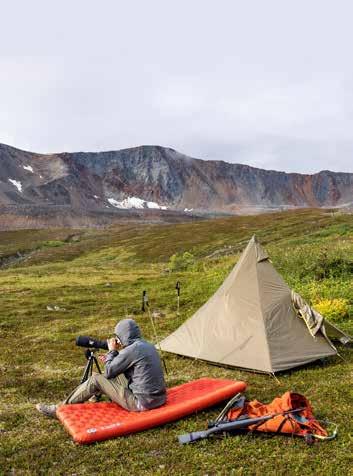


The fifth generation Pronghorn boot is everything you would expect from a legend and more. Featuring our Terra Force® Next™ platform, it’s lighter, faster and built to meet the demands of the hunt. Available online or at your local hunting boot retailer. DANNER.COM/PRONGHORN

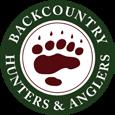

BHA chapters across North America are on the frontlines, battling attacks against our public lands and the North American Model of Wildlife Conservation and getting their hands dirty cleaning up public lands and waters.
• The Alaska chapter had a Pop-Up Pint Night in Anchorage on July 24 with a meet and greet with chapter board members and staff. Southcentral was excited for a BHA resurgence in the region.
• This year, the Alaska chapter, along with the Armed Forces Initiative and service members from Joint Base Elmendorf-Richardson, installed the final fencing along the Russian River ahead of the salmon opener. They worked alongside Forest Service and StreamWatch volunteers to place barriers and fencing protecting sensitive sites and archaeological digs. As they worked, they were regaled with stories and photos from the past, which showed the level of destruction before organizations stepped in to help.
• The chapter is planning its first annual board retreat on Kodiak Island around an invasive species removal of crayfish from Buskin Lake, a collaboration with the Sun’aq Tribe.
• The Arizona chapter completed volunteer improvement work on Perrin Ranch, which participates in the Adopt-A-Ranch program through the Arizona Game and Fish Department.
• Three separate showings of the Full Draw Film Tour were held throughout the state. The participation from the hunting community in Arizona was outstanding.
• A variety of events were held this fall for supporters of BHA, including a sporting clay shoot, mushroom hunt, family squirrel camp, volunteer work at Diablo Trust and pint nights.
• Arkansas Game and Fish Commission Large Carnivore Biologist Myron Means reports that remote cameras purchased with a donation from the Black Bear Bonanza are being used with great success. The cameras allow biologists to target specific bears for collaring or other research and also ensure safe capture when cubs are involved.
• The chapter has recently joined as a founding member the Arkansas Conservation Coalition – a group of conservation organizations that will unite to form a strong voice at the state and federal levels.
• The chapter held a Public Land Pale Ale release party at Flyway Brewery
on Sept. 12. BHA partnered with breweries across the nation to celebrate Public Lands Month.
• The Arkansas Public Waters Committee hosted the Lake Bob Kidd cleanup on Sept. 7.
• The Arkansas chapter is currently seeking volunteers to help with projects and events across the state. If you would like to get more involved, please reach out to arkansas @backcountryhunters.org
• AFI has been busy with many stewardship projects over the last quarter, giving veterans an opportunity to find a new mission in conservation, post-service. Events included fence pulls in Colorado and Montana, a range cleanup on Kirtland Air Force Base and a cleanup/goose-banding event in Nebraska.
• Reach out to your local chapter’s AFI liaison for ways to get involved next quarter!
• Our Annual General Meeting was held in June. The chapter welcomed Andrew Van Vliet as Provincial Chair and Steve Nikirk as Co-Chair. We thank Alan Duffy for his passion and dedication as past chair, as he continues on as the chapter’s conservation director.
• The chapter is participating in the provincial CWD working group, advocating for appropriate management of the disease by the province.
• Regional tables held several events: range and firearm safety day, trap shooting and learn-to-butcher, along with hosting educational speakers.
• The chapter held a Beer & Deer Pint Night presented by onX with North American board member J.R. Young.
• The chapter continued work protecting public access to the Truckee River, including engaging with state law enforcement agencies.
• The chapter continues to monitor the ongoing draft Black Bear Management Plan, identifying potential areas for expansion of hunting opportunities.

• Jerod Swanson volunteered to be the chapter’s Central Rockies assistant regional director, and Jarret Childers volunteered to be the chapter’s Southwest Colorado assistant regional director.
• The chapter joined our partners at Trout Unlimited in establishing Sportsmen for the Dolores, a coalition of hunters and anglers aimed at conserving fish and wildlife habitat and sporting opportunities in the Dolores River watershed of southwest Colorado.
• The chapter supported the Thompson Divide Mineral Withdrawal, protecting the region from proposed oil and gas development.
• Amendment 2, “The Right to Fish and Hunt,” will be on the ballot in Florida this November. Vote Yes!
• In June, the chapter hosted a deer-scouting educational event at Riverbend Park in Jupiter.
• This December the chapter will host a small game hunt at Dinner Island Ranch.
• The Georgia chapter has been monitoring new saltwater fishing regulations and the proposed mine at the Okefenokee Swamp.
• Idaho chapter members floated from Challis to Salmon for the 6th Annual Cleanup and Invasive Weed Pull along the world-renowned Salmon River.
• In North Idaho, members gathered for a foraging and forest health hike, where they learned about silviculture, as well as how to make syrup from foraged spruce tips.
• Members near Irwin spent a Saturday removing three dump trailers of barbed wire and other debris from the BLM’s newly acquired Irwin Recreation Site.
• The chapter spent the summer traveling the state with the Muddy Waters Tour. The tour is a compilation of several opportunities and events across Illinois designed to increase awareness, education and involvement in the conservation of Illinois waterways. If interested in hosting an event this fall, reach out to the chapter.
• The chapter hosted the Full Draw Film Tour at the historic Artcraft Theater in Franklin. The event was a wild success and our largest fundraiser of the year.
• The chapter has continued its work opposing the Benjamin Harrison National Recreation and Wilderness Establishment Act legislation (S. 4402, previously S. 2990), which seeks to halt USFS management projects that would diversify forest age class, improve oak-hickory systems and address the rapid decline in Indiana’s grouse population.
• With the Indiana DNR, the chapter hosted a frog giggin’ event at Goose Pond Fish and Wildlife Area, with over 50 attendees learning how to gig for frogs.
• In July, the chapter worked with the property manager at the 10,000acre Willow Slough FWA to remove old waterfowl resting area signs and install new ones. This project opened up some previously restricted areas to hunting and helped to improve the quality of the resting area, which will benefit all migratory birds.
• In June, the chapter completed its inaugural Bluegill Bash. Participants spent Father’s Day catching lots of panfish.
• The chapter auctioned off an Iowa Governor’s deer tag. $30,000 was raised with half of the proceeds going to the Iowa DNR and the other half to BHA.
• In August, the chapter held a gear swap at the VFW in Des Moines.
• In May, Kansas chapter members worked on clearing a new 40-acre tract of land at Sandhills State Park in Hutchinson. This area has hiking and equine trails and is open to limited public hunting access.
• In June, members hosted a Public Lands Appreciation Sporting Clays Shoot for Kansas Department of Wildlife and Parks public-land workers and their families. Walton’s provided bratwursts for lunch for all who attended.
• Also in June, BHA members worked to clean up the iWIHA area by Overbrook and partnered with the Pass It On program to help youth work on cleaning up a public shooting range by Jetmore.
• In May, the chapter held a 5th Anniversary Pint Night with TU, a Derby City Fly Fishers Pint Night, tabled at the Kentucky Elk & Outdoor Fest and held a Post-Season Turkey Talk and USCE Fish Habitat Build.
• In June, the chapter held a statewide event called Small Game Boot Camp, along with a How-To-Hunt Fort Knox Pint Night and an archery practice event.
• In July, the chapter held the Fire, Grasses and Beers Pint Night, a LearnTo-Fish Pint Night, a 7th District Pint Night, archery practice and a Higginson-Henry WMA Workday.
• The chapter board was asked to offer advice on whitetail management by the DNR, allowing us to weigh in on public land conservation in the state.
• The chapter held its annual Michigan Rendezvous with educational presentations, fun events, amazing raffle items and some delicious food as the focus of the weekend.
• Once again, the chapter partnered with the USFS to pull old cattle fencing on public land, helping both wildlife movement and hunter access.
• The chapter kicked off the summer with a great 3D archery event at Maryland’s famed Big Truck Brewery. They have a great 3D trail course, and the chapter is grateful to have been hosted by them. We’re looking forward to next year’s event!
• The chapter’s second annual Richmond Lowcountry Boil was held in early August with continued success. This event serves as a great outreach opportunity for the region, and we look forward to growing this event in the years to come.
• The chapter will host our Public Lands Pack-Out in partnership with the Virginia DWR at the C.F. Phelps Wildlife Management Area again this September for Public Lands Month.
• The chapter partnered with federal agencies USFS and USACE to clear trails and install waterfowl houses on public lands.
• The chapter kicked off deer season hosting several CWD-focused pint nights and sponsoring the Minnesota Governor’s Deer Opener.
• The chapter played a vital role in advocating for clarification on dog leash rules for Boundary Waters Canoe Area Wilderness hunters.
• The Missouri chapter relaunched operations in Springfield thanks to new chapter leaders Casey Callison and Aaron Samek! Please check out the chapter website or Instagram to learn more.
• The chapter had a busy summer with several pint nights, archery shoots, Full Draw Film Tour dates and public-land stewardship events.
• The chapter is looking to expand into the Columbia area for 2025. Please send us an email (Missouri@backcountryhunters.org) and let us know if you are interested in seeing BHA events in Mid-Missouri!

• The chapter celebrated a major legal victory in the UPOM case; a District Court judge denied UPOM’s motion for summary judgment, reaffirming the Public Trust Doctrine and ensuring wildlife remains public and not a private commodity.
• The chapter completed seven public land stewardship projects, ranging from fence removals to trail maintenance, with over 50 volunteers. Thank you to Timberline Ace, Gastro Gnome, Black Coffee Roasting Co. and RightOnTrek for supporting these projects!
• The chapter joined partners for the Ducks Unlimited duck-calling competition at the Sitka Depot, brought together members at a Missoula Paddleheads Game, raised awareness with Willie’s Distillery and joined the Gallatin Forest Partnership’s Wildlife Backyard Bash.
• Chapter leaders and members continued a fence removal project started last year in Halsey National Forest.
• Thank you to the Nebraska Bowhunters Association for allowing us to set up a BHA information tent and share in the festivities at the Jamboree.
• Chapter members helped rebuild fence at Hickory Ridge WMA back in August. A big thank you to all who attended.
• The Nevada chapter hosted a range day in Carson City and helped 20plus hunters get sighted in for the season ahead.
• Chapter board members volunteered with the Nevada Department of Wildlife to host hunter education.
• Monthly pint nights continue on the third Wednesday of the month at IMBIB Reno.
• Nevada Chapter Policy Co-Chair Molly Beaupre attended the BLM Nevada Recreation Summit in Reno to provide input on the challenges and opportunities we face in outdoor recreation on Nevada public lands.
• The chapter continued investing in Atlantic striped bass release mortality research being conducted by the Massachusetts Division of Marine Fisheries.
• The chapter assisted with camera trap placement, checking and maintenance for the University of New Hampshire’s Wildlife Management and Modeling Lab.
• The chapter sponsored the Rhode Island Youth Waterfowl Training & Mentored Hunt, organized by the Rhode Island Department of Environmental Management Fish & Wildlife Division.
• Chapter members worked with Forest Service staff to repair and replace fencing around the Sargent KV trick tank in the San Mateo Mountains in order to exclude cattle from the area but still allow wildlife access.
• Over the course of three stewardship events, chapter members have improved wildlife connectivity on over 10 square miles of habitat on the Rio Grande Del Norte National Monument. In June, they removed 1.5 miles of old fencing, which was replaced with wildlife-friendly fencing by the BLM. In July, they modified one mile of fencing to meet the wildlife-friendly fencing guidelines. In August, chapter members removed almost two miles of netwire fencing, reducing the chance of wildlife entanglement.
• The chapter hosted a Full Draw Film Tour event in Albuquerque and had a great turnout.
• Chapter volunteers worked alongside the New Mexico Department of Game and Fish biologists and volunteers from RMEF on the Marquez/L-Bar WMA to remove fencing, which will improve habitat permeability for crucial elk calving areas.
• The chapter worked to push a bill granting more flexibility on licensing and tagging methods (including electronic) and to remove the requirement to wear a back tag. The bill was passed and signed into law just before session closed.
• The chapter partnered with Hunters of Color and Columbia Land Conservancy to host a weekend turkey camp for 10 new hunters of color. Hunters were on birds both days, and one hunter even tagged out!
• The chapter hosted an event at Filson NYC with Melanie Sawyer, a New York-based contestant from Alone Season 10. Melanie put on an amazing presentation, showing the gear and skills she used to survive 43 days in the wild.
• The chapter partnered with the Armed Forces Initiative to reconstruct a long-ago decommissioned fishing pier at Hammocks Beach State Park. The renovated pier will provide public access to fishing in Bogue Sound.
• A successful Conservation Banquet in Charlotte celebrated numerous conservation and policy efforts during the past year.
• The “Water Access Wars” have arrived in North Carolina. The chapter is looking for ways to support the fight for public access on the Boone Fork of the Watauga River.
• The North Dakota chapter has launched a chapter podcast and has recorded seven episodes with guests such as Randy Newberg, Hal Herring and multiple wildlife health professionals.
• The chapter completed its annual gun raffle and hosted our first Full Draw Film Tour in Fargo in August.
• The chapter will participate in the 6th Annual Badlands Classic in Medora.
• The chapter is preparing to comment for a much-needed Travel Management Plan for the Little Missouri National Grasslands.
• In March, several chapter leaders and members traveled to Bentonville, Arkansas, to partner with the Arkansas chapter to host the 3rd Annual Black Bear Bonanza. Attendance was over 1,200 people from numerous states and even Canada!
• The Oklahoma chapter hosted the International Fly Fishing Film Festival at Circle Cinema in Tulsa on March 14.
• Members of the Oklahoma chapter placed third in the Wild Game Cook-Off at the North American Rendezvous! Watch out next year!
• The Oklahoma chapter once again partnered with Quail Forever on a habitat project at Osage Rock Creek Wildlife Management Area on June 8.
• On July 30, the Oregon chapter of BHA submitted comments and petition opposing e-bikes on specific trails within the Deschutes National Forest. The proposal by the US Forest Service would authorize the use of Class 1, pedal-assist e-bikes on 161.4 miles of previously non-motorized trail within the Sisters and Bend – Fort Rock ranger districts of the Deschutes National Forest.
• Ultimately, the Oregon chapter was able to garner over 200 signatures in opposition to the proposal.
• The chapter exhibited at several summer events including the Pennsylvania Elk Expo and Explore PA Outdoors, sponsored by the Pennsylvania Game Commission and the Department of Conservation of Natural Resources, in Pittsburgh.
• The chapter was featured in an article by USA Today outdoors columnist Brian Whipkey for their policy, R3 and stewardship work across Pennsylvania.
• Public Lands Month was busy with events across the state including collaborative pint nights in Western Pennsylvania, National Hunting and Fishing Day exhibits, mentored hunting with the Pennsylvania Game Commission and a habitat workday in Gallitzin State Forest in partnership with the Western Pennsylvania Conservancy.
• The chapter represented BHA at the National Trapper’s Association Convention in Sioux Falls.
• The chapter hosted a lake cleanup as a part of the Adopt-A-Lake program in celebration of Public Lands Month.
• Louisiana has re-established a black bear season. The details are not yet finalized, but a lottery-style draw will be required to acquire a permit. There is also a provision allowing a single auction permit. This is a huge win for hunting and conservation in Louisiana.
• Also in Louisiana, new red drum size and daily creel limits are in effect as of June 20, 2024. Be sure to familiarize yourself with the new regulations before your next Louisiana fishing trip.
• In Alabama news, the Southeast chapter supports legislation that has been introduced in the House and Senate to preserve a submerged ancient forest, mostly cypress trees, located offshore of Gulf Shores, Alabama. The legislation would designate the underwater forest as a National Marine Sanctuary to safeguard the underwater forest from exploitation. Once the designation is secured, the location of the underwater forest, which has been closely guarded since its discovery, may be revealed to allow recreational anglers and divers an opportunity to visit.
• We are still looking for active members interested in chapter, state and local leadership roles!
• The Tennessee chapter, in conjunction with the Tennessee Wildlife Resources Agency, helped band doves. TWRA will use this data to better understand the lifecycle of doves in a hunted landscape.
• The manager at Percy Priest WMA outside of Nashville asked the chapter to help restore grassland habitat. The particular spot he needed help with had been invaded with Bradford Pear trees. A crew of chapter volunteers armed with chainsaws and squirt bottles took down an entire stand on a hot morning in July.
• In support of September’s Public Land Pale Ales, the chapter collaborated with New Heights Brewery in Nashville. New Heights hosts a monthly BHA pint night on the third Thursday of the month at 7 p.m. Cheers!
• In late August, the state filed a lawsuit with the U.S. Supreme Court attempting to wrestle 18-million acres of public land away from the BLM and into state control. The chapter and BHA Headquarters have launch a full-scale opposition effort. Learn more on page 20 and get involved!
• A Walk-In Access appreciation event was a tremendous success, providing attendees with valuable insights in accessing participating private lands for hunting and fishing. Attendees extended their heartfelt gratitude to all participating landowners in the Walk-In Access program by sending personalized thank you cards.
• We were excited to wrap up our Hunting for Sustainability series with an engaging butchering workshop, where participants learned handson skills for processing game meat. This final event aimed to equip hunters with the knowledge to utilize their harvests to the fullest.
• The Horse Creek Wet Meadow Restoration Project outside of Helper made significant strides toward revitalizing crucial habitat, benefiting a diverse range of local wildlife, including sage grouse. The Zeedyk and dam structures constructed by volunteers will increase water retention and plant diversity, enhancing the overall ecosystem health in the area.
• The Washington chapter took home Chapter of the Year at BHA’s Rendezvous in April! The chapter is honored and fired-up to continue their good work in Washington State.
• The 6th Annual Methow Fence Project was completed in the beginning of May. Volunteers and BHA members tore out fence to increase migration corridors in the Methow Wilderness.
• The chapter held its first ever state rendezvous. Over 160 people attended and raised over $17,000 in gross revenue.
• The chapter held its third annual Sultan Basin public land cleanup in partnership with WDFW and Trash No Land. Members picked up 2,072 lbs of trash.
• The chapter sponsored the Western Association of Fish and Wildlife Agency’s 34th Biennial Sage Grouse Workshop in Wenatchee. Sage grouse are critically endangered in Washington State, and the chapter engages in solar siting mitigation, prescribed burn planning and habitat restoration as part of recovery efforts.
• On Sept 7, the chapter worked alongside the West Virginia Deer Association for a habitat improvement project at the Burnsville WMA, removing invasive species in a previous edge cut as well as girdling trees in burn unit.
• The chapter participated in the West Virginia National Hunting and Fishing Day Celebration on September 21 at Stonewall Resort State Park in Roanoke, sponsored by the WVDNR.
• The chapter is organizing a Sportmen’s Capitol Conservation Day, which will take place on the lower rotunda of the state capitol on Feb. 21, 2025 from 8 a.m. to 2 p.m. We will be joined by other sportsmen’s groups from around the state to educate legislators on what we are about and speak to them about the things that are beneficial to our mission.
• The chapter partnered with the Wisconsin Department of Natural Resources to arrange a chainsaw safety course, enabling our members to operate chainsaws on Wisconsin’s state lands for habitat work.
• The chapter organized several R3 events over the summer, including sessions on fly fishing in the Wisconsin Driftless Area, training for black bear hunting with hounds and a morning of spearfishing for panfish, where members learned to use a spear and clean their catch.
• The chapter was invited to participate in the August meeting of the Wisconsin DNR Chronic Wasting Diseases Committee. Our organization will join other conservation organizations and state leaders to provide valuable insights on this issue. Wisconsin BHA also participated in the June Wisconsin DNR Conservation Roundtable, which was geared at discussing the DNR’s structural deficit in its fish and wildlife account.
• The chapter worked to protect hunter and angler investments in wildlife management through opposition of and an action alert over proposed excessive rangeland damage regulation changes.
• The chapter supported the successful Munger Mountain Recreational Lease proposal, helping preserve hunting access and preventing development on a 640-acre state property for a 35-year lease term.
• Chapter members and stewardship staff successfully completed a fence removal project with BLM wildlife and range staff to remove dilapidated fence, which forms the boundary of the Sweetwater Canyon Wilderness Study Area.
Find a more detailed writeup of your chapter’s news along with events and updates by regularly visiting www.backcountryhunters.org/chapters or contacting them at [your state/province/territory/region]@backcountryhunters.org (e.g. newengland@backcountryhunters.org).




NRS Approach rafts give you the flexibility to fish anywhere, anytime, anyhow. They’re designed to fit between the wheel wells of a full-size truck on the roof of an SUV—no trailer or boat ramp required. Every detail has been examined for angler comfort and convenience. The NRS Slot Rail frame system lets users easily adjust the placement of the seats, oar mounts, and foot bar to optimize the rower’s position and weight distribution. You can also dial in your setup for the coming adventure, from full-luxury fishing to an ultralight format for light-and-fast missions. We include dry box seats, integrated angler trays and rod holders, a quick release anchor system, and motor mount. 16-inch side tubes and a thick drop-stitch floor insert enhance buoyancy, and welded PVC construction resists abrasion on shallow and overgrown streams. No boats give you more options for exploring different ways, and places, to fish.



BY CLAIRE McATEE
On the third Saturday of October 2022, I woke up at 5:15 a.m., jumped out of my dorm bed and put on layers and layers of clothes, careful not to wake my roommate. I grabbed snacks stolen from the dining hall and slung my borrowed pack over my shoulder. As I strutted out of my dorm in full camo and into the frigid morning, I knew I was one step closer to being a badass.
I met up with a new friend, Nicole, at a trailhead deep in national forest land. It was still dark when she handed me her rifle and a blaze orange vest and told me to keep up.
During my freshman orientation at the University of Montana, I was introduced to BHA’s college club. Nicole was the president. Apart from her, the club looked like one giant testosterone cloud. Joining felt like asking to be mansplained to. But Nicole sucked me in, reassured me, and now I am her successor.
As we hiked higher and higher, the light rain turned into snow. We parked ourselves under an evergreen on the face of a small mountain to glass for whitetail deer. Nicole whispered the plan for the day: If we see a buck, it’s hers; if we see a doe, it’s mine. At midday, we’d meet up with another one of her friends hunting close by.
I was two months into my freshman year and already doing exactly what I came there to do. I’m studying journalism, but my primary focus is in wildlife biology. I grew up bird hunting and bass fishing in South Carolina and hoped I could somehow make a career out of it.
But chasing big game in Western Montana is a little different than the hunting I grew up with.
That first day, I wasn’t president material. We pushed deer all through the woods. I’d step on a twig and see a flash of white out of
the corner of my eye, a whitetail hauling in the opposite direction, tail held high. Deadfall and the slippery wintery mix amplified my usual klutziness.
During our midday rally with Nicole’s buddy, it was decided that we would listen for each other’s gunshots and come to help with a potential harvest.
About two hours later, shots rang out.
Nicole and I hiked over and peered down a steep ravine to see a downed bull elk with our friend standing over it.
It took almost 4.5 hours to field dress the bull. This was the biggest animal any of us had ever dealt with; and on top of that, I had asked my mentors to explain the process to me, so that I would know what to do in the future.
Cold, wet and tired, I hoisted 100 pounds of elk onto my back and began the trek back to the trailhead. My first big game chase turned into a brutal dark-to-dark hunt and one of the most exhilarating experiences I’d ever had, and it wasn’t even my harvest.
The next day, my legs were Jell-O from the previous pack-out, but I had been bitten by the backcountry bug and was ready to have my shot at things (pun intended). Nicole and I hiked for just a few hours before we spotted a doe grazing above us. I slowly unclipped my pack and got in the prone position. I felt myself shaking but Nicole whispered for me to hunker down and wait.
Two minutes later, I clicked off the safety on Nicole’s rifle, peered through the scope, emptied my lungs, and took the shot.
After a high-five, a snack and an excitement-induced bathroom break, we weaved through the trees to find the whitetail where she had dropped.
After a much quicker pack-out than the day before, I had my own trunk full of meat and a new passion.

Before Nicole began personally mentoring me, she had reached out about participating in the club’s annual Learn to Hunt program. Montana Hunter Mentorship has been happening every November since 2013 at a cabin in Philipsburg where newbies are matched with a mentor for an entire weekend of boots-on-the-ground learning.
James Goerz, an ex-Marine living in Philipsburg, is also an alum of UM and its hunting club. It’s his cabin we go to every year for the event. That year, about 20 new hunters joined the club over two weekends. I saw firsthand why organized hunts like this are the key to people like me becoming involved, becoming leaders and showing the people who come after us why they should hunt.
Goerz, who started Montana Hunter Mentorship, recognized that learning to hunt in Montana is daunting. “We tried to eliminate all of the barriers,” Goerz said. “All you have to do is show up.”
The support system programs like this provide is the key for many hunters getting into it in adulthood; a network of mentors who share their expertise, loan gear at no cost and provide accessibility. Plus, mentors often become long-term hunting buddies to those who start as mentees.
Nicole, who has now graduated and has a “big-girl” job researching elk, is always the first to hear from me after a hunt: where I’ve been, what I saw and what my next strategy is. Goerz, or “Uncle James” behind his back, always peppers in life lessons to our mentorship business calls. These are the people to whom I owe my hunts.
UM BHA’s program isn’t the only of its kind; learn to hunt programs are found all over the country.
BHA’s Hunting for Sustainability program is a broader effort to
recruit new hunters nationwide. In December, I volunteered with the program for their annual Learn to Hunt Waterfowl workshop at Teller Wildlife Refuge in Corvallis, Montana. I witnessed new hunters dive into duck hunting. And this time, it wasn’t just college kids.
I could list a hundred reasons why I hunt. It gives me an unparalleled sense of self-reliance. It’s gratifying, even if your day ends without a harvest. There is pride in navigating wild areas, noticing tracks and following them for miles; feeding yourself the hard way; being forced to trust your instincts and rely on the skills you’ve learned. This pride breeds confidence, especially as a young woman conquering life in a new environment.
Last fall, I hunted alone for the first time. Every weekend, I added miles in the mountains trying to find a buck worthy of being my first solo harvest. Every second I spent in the woods added to my knowledge of the chase and my connection with the land and its resources.
In November 2023, a new group of hunters gathered at the Goerz Cabin for the ninth year of Montana Hunter Mentorship. This time, I was there not as a mentee, but as the coordinator. I hope that the weekend produced 20 new conservationists, whether that’s manifested in a life of hunting or just one-time exposure to what I love.
Claire McAtee is an undergraduate student in wildlife biology at the University of Montana, where she is also the president of the university’s BHA collegiate club. Her time between classes is spent hunting and angling throughout Western Montana.

MAXIMIZED VERSATILITY
Based on new revolutionary material technology, R8 Core is designed with a forward-thinking lens of what we’re seeing out on the water where one rod needs to show even greater range.





BY KADEN McARTHUR
With 640 million acres of federal public lands in the United States, the nation’s hunters and anglers have unparalleled opportunities to pursue fish and game without relying upon private landowners for access. Further, important habitat and migration corridors that exist on public property can be conserved through federal land management agencies and landscape designations.
Stewarded by different agencies, the laws that safeguard these public lands and waters can vary considerably depending on the managing agency. As dedicated conservationists, maintaining a firm understanding of how the different agencies operate allows us to have the most effect on the issues most critical to hunters and anglers.
The largest portion of our public land estate, 245 million acres, is stewarded by the Bureau of Land Management. These lands are found primarily in 12 western states. Under their multiple use mandate, BLM lands are open to hunting and fishing. Whether it’s hunting pronghorn in the Color Country BLM district of southeastern Utah as I have, or pursuing mule deer in the Missouri Breaks of Montana, BLM lands provide countless opportunities for the hunter and angler.
Managed by the BLM, the National Conservation Lands are comprised of 37 million acres, or 15% of all BLM lands. This designation includes national monuments, national conservation areas, wilderness areas, and other landscapes prioritizing opportunities for hunting, solitude, wildlife viewing and fishing.
The Federal Land Management and Policy Act (FLPMA) of
1976 is the guiding law for the BLM, establishing the agency’s multiple-use and sustained-yield mandate. Under this mandate, the BLM has been tasked with managing energy development (both traditional and renewable), mining, grazing, timber harvest and outdoor recreation.
In 2024, pursuant to FLPMA, the BLM finalized the Conservation and Landscape Health Rule, commonly referred to as the Public Lands Rule. In addition to improving science- and data-driven landscape management decisions, the Public Lands Rule “recognizes conservation as an essential component of public lands management, on equal footing with other multiple uses of these lands.”
This rule received applause from BHA for the long overdue elevation of conservation as a use of BLM public lands equal to others.
The U.S. Forest Service manages 193 million acres of public land in our National Forest System. Forty-four states have national forests, or national grasslands, managed by the USFS. Under the multiple-use mandate of the USFS, national forest lands are open to hunting and fishing. Chances are, most of us public land users have countless memories on National Forests – whether it’s spot-andstalk hunting black bear on Idaho’s Salmon-Challis National Forest like me, or prospecting for brook trout in Pennsylvania’s Allegheny National Forest or myriad other opportunities. East to west and north to south, our national forests provide an incredible diversity of experiences for the public-land recreationalist.
In 1960, the Multiple-Use Sustained-Yield Act required, for the first time, that the five major uses of the National Forest System (timber, range, water, recreation and wildlife) would have no one greater than the other. This ensured that wildlife habitat along


with hunting and angling opportunities would be prioritized by the USFS alongside other uses.
Decades later, in 2001, the USFS finalized the Roadless Area Conservation Rule, commonly known as the Roadless Rule. Surveys were conducted on managed national forest lands to assess their undeveloped qualities. Fifty-eight million acres, or nearly one-third of the public land managed by the USFS, are designated as Inventoried Roadless Areas, which maintain that undeveloped character.
The Roadless Rule did not close existing roads or trails, and exceptions to roadbuilding include access to non-federal land inholdings and preexisting mineral leases. Timber harvest is permitted to reduce fire risk or to improve habitat for endangered species.
Despite the Roadless Rule, the National Forest System contains twice as many miles of roads than the entire U.S. Interstate Highway System. BHA has long supported the USFS Legacy Roads and Trails Remediation Program, which was permanently authorized in 2021 through the Bipartisan Infrastructure Investment and Jobs Act. Projects implemented under this program are utilized for necessary road decommissioning, repair and maintenance of roads and trails, and the removal of fish passage barriers.
The U.S. Fish and Wildlife Service manages 95 million acres of public lands (and 750 million marine acres) through the National Wildlife Refuge System. Every state is home to a national wildlife refuge. At the time of writing, hunting is allowed on 436 units of the NWRS – including the Bear River Bird Refuge in northern Utah where I’ve spread my decoys countless times. Fishing is also allowed on 378 units.
National wildlife refuges are the only public lands managed pri-
marily for fish and wildlife conservation. In accordance with the National Wildlife Refuge System Improvement Act of 1997, the NWRS is managed for six priority wildlife-dependent recreation uses: hunting, fishing, birding, photography, environmental education and environmental interpretation.
As of Aug. 1, 2024, the USFWS is currently considering a Hunting and Sportfishing Rule that would expand hunting and fishing opportunities on 12 national wildlife refuges encompassing 211,000 acres which is set to be finalized before hunting seasons open this fall.
The National Park Service stewards 85 million acres of public lands in the National Park System. Each state contains NPS managed lands. The mission of the NPS is centered on preservation, rather than multiple use. Nevertheless, opportunities exist, such as the mountain streams of Shenandoah National Park in western Virginia where I have cast my fly to brook trout.
Under the National Park Service Organic Act of 1916, hunting is prohibited in national parks and lands managed by the NPS unless otherwise specified by law. However, unknown to many, 51 million acres of NPS-managed public land (primarily, but not exclusively, in Alaska) are open to hunting – in national preserve units and other designations. In contrast, fishing is allowed on lands managed by the NPS, unless otherwise specified through unit-specific regulations.
In addition to various public land management agencies, which allow for varying degrees of multiple use for industry, recreation and conservation, there are several important designations across our nation’s public lands to improve their management for intact fish and wildlife habitat.
In 1906, the Antiquities Act was passed granting the president and Congress the authority to establish national monuments to protect cultural and natural resources of historic or scientific interest, while respecting valid existing rights.
Early national monuments were managed by the NPS and as such prohibited hunting. However, beginning with the establishment of the Grand Staircase-Escalante National Monument in 1996, the BLM and later the USFS would manage many larger western national monuments and allow hunting. As a result, the vast majority of public lands within national monuments are open to hunting and fishing.
National monuments offer significant conservation value by prohibiting new development on public lands. BHA has ardently supported the Antiquities Act, despite administrative and congressional attempts to erode this bedrock conservation law. As a gridlocked Congress has increasingly been unable to advance legislation in response to any timely threat to our natural resources, use of the Antiquities Act has become an increasingly important tool allowing the president authority to conserve our public lands.
BHA supports proposals to sustain hunting and fishing opportunities while permanently protecting public lands; current priorities include the Owyhee Canyonlands National Monument in southeastern Oregon and Dolores Canyons National Monument in southwestern Colorado.
Passed in 1964, the Wilderness Act established a designation to
conserve the most intact public lands, prohibiting motorized equipment or mechanized transport to maintain the primeval character of these untrammeled landscapes. One-hundred-eleven million acres have been designated within the National Wilderness Preservation System, found in 44 states on lands managed by the USFS, BLM, USFWS and NPS.
Additional wilderness areas can be designated through an act of Congress, and BHA is advocating for multiple pieces of legislation that would designate more than 4.5 million acres of new wilderness areas from Alaska down to Arkansas.
It is critical to familiarize ourselves with the history and the management of our public lands, both to maximize hunting and fishing opportunities, and also to understand the role that the conservation of wild landscapes plays in providing those opportunities. As BHA moves toward its 21st year, the mission is unchanged, and we will continue to advocate for the incredible resource that is our public lands.
Kaden McArthur is BHA’s government relations manager. A western hunter and angler, his passion for wild places and wildlife brought him to Washington, D.C., where he leads BHA’s work on federal conservation policy.
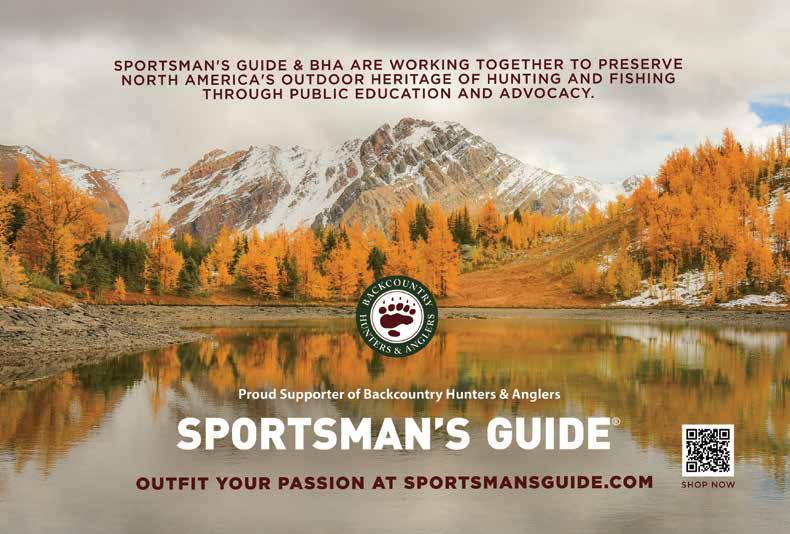


BY CHARLIE BOOHER
Hunting and fishing are some of the oldest forms of recreation. Even when these pursuits were necessary for our own survival as a species, they were also a source of joy and a mechanism for connecting with the world around us.
Today, hunters and anglers are joined by a veritable army of other recreationists on the landscape. Bikers, hikers, paddlers, ORVers, berry pickers, recreational shooters, cinematographers, mushroom hunters, campers and others share our public lands with us, in addition to the industries that operate on these same lands. Especially since the COVID-19 pandemic began, recreationists of all stripes have flocked to the outdoors.
In fact, more Americans than ever are choosing to recreate outdoors at our national parks and public lands. The major federal land management agencies saw over 580 million visitors in 2023, including 312 million visitors to National Park Service sites, 67 million to U.S. Fish and Wildlife Service National Wildlife Refuge System lands, 42 million to Bureau of Land Management public lands, and 159 million to U.S. Forest Service areas last year.
Where our most popular public lands have been overrun, the laws, rules and systems by which they are managed are in need of an update.
As we near a lame duck session of the 118th Congress, the members of that body are searching for priorities that can achieve broad, bipartisan support. Because so many Americans commit our time and treasure to all forms of outdoor recreation, it is one of the few remaining bipartisan issues and is well suited for action at a time when little else is.
As of this writing (August 2024), both the Expanding Public Lands Outdoor Recreation Experiences (EXPLORE) Act (H.R. 6492) and America’s Outdoor Recreation (AOR) Act (S. 873) are
awaiting action. These bills constitute comprehensive, bipartisan and bicameral legislation that is the culmination of several committees’ yearslong effort to advance legislation to increase access to outdoor recreation opportunities and support our $1.1 trillion outdoor recreation economy.
“By passing comprehensive outdoor recreation, wildlife conservation and public land management legislation, Congress can take action to reflect the overwhelming support across the United States for improving our shared lands and waters. This bill will modernize outdoor recreation management, make our public lands and waters more accessible and provide significant benefits for hunters and anglers as we pursue our sporting traditions,” said BHA Government Relations Manager Kaden McArthur. “We thank chairmen Westerman and Manchin and ranking members Grijalva and Barrasso for their bipartisan leadership on this priority and look forward to working with all four of them to swiftly to send this legislation to the president’s desk.”
EXPLORE and AOR are considered recreation “packages” because each are composed of several smaller bills. Both packages include several benefits to hunters and anglers, as well as the balance of the outdoor recreation community with which we work.
First and foremost, EXPLORE and AOR aim to simplify the permitting processes for accessing public lands and waters (think campground and float permits, but also vendor permits for guides and outfitters) by reducing costs and wait times and streamlining processes. Notably, the bills also include the Federal Interior Land Media (FILM) Act, which would eliminate fees and permits for small groups filming on public lands, making it easier for outdoor enthusiasts and small-scale operations to share their experiences with the public.
This package would require federal land management agencies – notably the BLM – to update vehicle-use maps on public lands
within five years, with continued updates every 20 years. This measure will ensure that accurate and up-to-date information is consistently available, improving navigation and access for all users.
The Range Access Act, which is also included, would create fee-less public shooting ranges in each BLM district and national forest and will provide more opportunities for hunters to prepare for hunting seasons and reduce conflicts created by informal shooting ranges. Congressional leaders hope that by consolidating recreational shooting activities, they can reduce litter and promote safety on our public lands, which will be of benefit to hunters and other recreationists alike.
The Cape and Antler Preservation Enhancement (CAPE) Act is also part of this package and would help improve the use of “qualified volunteers” to execute wildlife management activities in the National Park System. These volunteers – often hunters –are authorized to undertake certain actions within the Parks on behalf of NPS, like culling non-native mountain goats in places like the Grand Tetons. If this bill becomes law, it will authorize the donation of hides, horns and antlers harvested in the National Park System. This will prevent waste and ensure respectful utilization of harvested animals that currently have to be left to lie in the field due to NPS rules.
Further, these bills include the Military and Veterans In Parks (MVP) Act to improve outdoor recreation experiences for military servicemembers, veterans and Gold Star Families by expanding
free passes and reduced-cost permits.
Lastly, EXPLORE and AOR would establish a grant program for the inspection and decontamination of watercraft to prevent the spread of aquatic invasive species, protecting our waterways and ensuring their health for fishing and other recreational activities.
While the EXPLORE Act and AOR Act are substantively similar, they will require some (albeit minor) reconciling between the House and Senate before they can be sent to the president’s desk. I sincerely hope that that has already happened by the time you are reading this.
As you might imagine, a great deal can and will change in the next few months. However, the need for a comprehensive approach to modernizing outdoor recreation management and expanding access will most certainly not go away. And, perhaps more importantly, the team of advocates at BHA and beyond who work these issues daily certainly aren’t going anywhere either.
BHA member Charlie Booher is a conservation lobbyist at Watershed Results LLC and holds degrees in wildlife biology, public policy, and natural resource conflict resolution from Michigan State University and the University of Montana. Outside of the office, you can find him hiking the mountains of Western Montana and relearning how to hunt and fish in the Northern Rockies.

Experience shaving sharp edges on all your knives.
The KNIFE & TOOL SHARPENER Mk.2 is easy to use and delivers best-in-class sharpening for all knives and edged tools.
Sharper than the day you bought them. LEARN





































































































BY JAKE FORREST LUNSFORD




No one living today knows how the Crazy Mountains got their name. A white woman driven to madness by the violence of her family’s massacre? Crow chief Plenty Coup’s vision of his own death in a log cabin, where he would live long enough to see the bison replaced by cattle? The inability of settlers to understand the sign language of the Plains Tribes? My own sense is that they have another name, one older than stories tied to the arrival of settlers, or of the subsequent Tribal apocalypse; something beyond the dark omens placed upon them. But I don’t know what that name is, so I call them the Crazies, just like everyone else. Let the Earth keep her secrets.

Ranch houses stand scattered within the arroyos and creek bottoms that cut the downslope plains, miles from their nearest neighbor, mirroring the isolated geography of the range. To the north and northeast lie the Musselshell River, the Little Belt Mountains and the Big Snowies. To the south and southwest the Yellowstone River flows, and the Bridger Range and Absarokas beyond that. To the west, the Rocky Mountain Front emerges, jagged and foreboding. The Great Plains roll away into the east forever. But the Crazies stand sentinel before them all. They are the western gatekeeper. It is a windy place – and cold.


The Crazies rise from the prairie in what can only be described as a geologic eruption. After so many days crossing the openness of the plains, they spring forth, abrupt and guarded in their solitude. Hidden beneath the snow-capped peaks and fire-christened slopes, a checkerboard of private and public lands sets a chess match before those who dare enter into the game of access. To penetrate into that vastness, better to play the Rook over the Bishop; there will be no corner crossing here. To reach their slopes you will park your truck in the ditch of a gravel road, walk for miles, and still not be within the folds of public land.

Into this solitude we march, my son and I, who only the day before turned 13. The wind rakes so violently across the transition range that we lean into it to keep from falling over before reaching the shelter of the mountains. But there is no shelter, only a change in the angle of the wind. Purple shades of roadless backcountry and crinkled elevation lines tighten and darken around and above us, marking the high and craggy places of rock and ice where others are unable, or unwilling, to go. We set camp and rest in the crook of a stream bed, just beyond the border of where the ranch we traveled across changes from something I will never have into something that has always been mine. This is the path less-traveled, at least for today, and the valley belongs to us alone.




A son is born.
He is small and wrinkled and pink like an old man too long out of the sun. He screams and shits and cannot be reasoned with, and his screaming and shitting and close-fisted rage boils an anger within me, too, a thing I did not expect. I change his diaper and walk away, and his mother takes him and he is silent again. He loves her more than me, and that hurts, too, but it makes me melancholy and not angry, like the screaming. It isn’t supposed to be this way, I think, but don’t know how to say. But I am 25, and full of angst over the war that has consumed my youth, and I cannot accept that he will always love her more than me. Only time will show me that this is the way it has always been between fathers and sons.
Time evaporates here. I measure its passing in elevation gained rather than hours or days passed, noting where the sudden flush underfoot is no longer a covey of Huns flying low over the prairie, but a brace of Duskies dodging through the firs. Forty yards to the front a bear crosses our path. Upwind and comfortable in the tall grass, he sits and looks up the mountain, and we stay with him for a spell. We cannot see what he sees, but through the rising of his nose and the tilting of his ears we sense the herd of elk traveling upslope through the deadfall and timber. When he rises, we kneel, and he passes on.
at least for a time, but as a warrior who still smells of moon dust and violence and the acridity of gun-smoke. He barely knows who I am. I know that in a few days he will smile at me again, and in a few weeks there will be baseball and marshmallows in the front yard and a feeling of normalcy. And in a few months, I will be gone again. Best to focus on tomorrow and let the rest come as it may.
I have a son in this wilderness, and he smiles at the snow, and it is all I can do not to cry about it in front of him. I’ll stay with him, my back cold against the night, being quiet and present and just a bit melancholy, until he is ready to turn in, because we both know this won’t last forever.
In the late autumn, snows have only just begun to fall, and the elk remain up high, so we climb. Slowly the Douglas firs give way to hardier Englemann spruce, and then again until all that remain are the broken and disassembled relics of stunted offspring who tested the limits of soil, and of oxygen. Bare rock and crushed gravel mark the upper elevations. And the wind is always shifting.
The specter of wind is always moving in this place. You can see it traveling through the conifers, giving motion to stale limbs as it combs its fingers through the dry needles. You can hear it in the constant rustle of buffalo grass underfoot and the hollow rush of its passing through the valleys. You can feel it clawing under your collar and penetrating the resolve that keeps you here. Why have you come? it whispers. When you answer, it carries your words away like the legions before who sought what you seek, blown away and left on the aeolian deposition of time. Nothing remains in the end, and even the rock faces are ground away by sand carried in the gale. Only tomorrow will you see it for what it is. But you are already gone.
Seven years old.
I calculate the months and years that I have been away and realize that it is over half his life. His mother has been here all this time, and he clings to her subconsciously, looking away, his two little brothers doing the same, and I don’t realize it now in the airport parking lot, because I am just trying to hold it together and accept whatever this is. But in the dark of my living room, after he has gone to bed, I try and see through his eyes. His mother will be there in the morning, making him breakfast, being constant, being what he knows. I will be there as well,
Tomorrow will bring strings of horse-mounted guides and hunters with mules hauling wall tents and pot-bellied stoves, and hikers packing deep where there is no water. There will be donkeys traveling without lead ropes to campsites only they seem to know, owners content to follow the musings of a jackass. Stories will collide and intertwine over campfires shared and elk chased in competition, congratulations and curses doled out accordingly. Tomorrow, a cold front will assert itself on the camps of our valley, driving men to the trailhead, horsehair and tent canvas whipping in the gale, days on end of biting winds and bitterly cold snows piling against the northwest side of every standing thing. The valley suddenly ours again, we will shelter between the thin walls of a tipi, wrapped in down and covered in wool, Nate Schweber’s This America of Ours helping to pass the time until the storm passes. But it never does, so we turn our faces into the wind, and we hunt. On the leeward side of downed trees upturned by old storms, we will find shelter and build fires where the musk of elk draws us into pockets of tranquility, the ground still warm from bodies more suited to this landscape than our own. Boots will freeze, tears will freeze, and even bodies will freeze to the ground lying in wait for a moment, a collision of man and beast, I only now know will ever come.
Ten years old.
Eventually we learn. Act like this is just another Tuesday. Don’t make a party out of leaving, and don’t expect one coming home. Act normal, and you will be normal, just like they told Grandpa when he got home. Kiss Mama, hug the boys, and let the truck carry me down that gravel road to the edge of an ever-expanding empire.
A bull will fall, anchored to the earth by powder and lead, and his weight on our backs will drive our heels into the dirt as we carry him home. Bones and hide and evidence of our bloody scuffle on the snow will remain, but his journey does not end there. At camp, we will celebrate and mourn and hold tenderloin out over open flame. Blood on our hands, joy in our hearts and meat in our bellies; this is the way. Through it all I watch quietly in the light of each night’s fire as a boy becomes a man.
He sits across the fire in this storm. Others in the valley have given up and gone home, but departure, for me, is unfathomable. My world has shrunken to this circle of light cast by the flames. I have a son, right here, right now, and that is enough to hold back legions of whatever doubt would otherwise drive me away from this
I know too that he’s something that only came to be because of my absence and his mother’s Spartan-like resolve, and I wonder if it wasn’t better this way after all, and that’s hard as well. So, we stare at the fire, ancestor-like in silhouette, and listen to the wind blowing life into the coals.
place. I have a son in this wilderness, and he smiles at the snow, and it is all I can do not to cry about it in front of him. I’ll stay with him, my back cold against the night, being quiet and present and just a bit melancholy, until he is ready to turn in, because we both know this won’t last forever.
This isn’t about elk. It’s about time, and being present, and not looking away. It’s about reaching across all those years we lost from each other to a cause, a mission, a duty I thought was worth leaving him for. We don’t talk much, and that seems fine. I look at him and know that he’s been there for his brothers when I wasn’t. I know too that he’s something that only came to be because of my absence and his mother’s Spartan-like resolve, and I wonder if it wasn’t better this way after all, and that’s hard as well. So, we stare at the fire, ancestor-like in silhouette, and listen to the wind blowing life into the coals.

Talk is sparse the 2,400 miles home. There is a stop in eastern Montana and a half-assed effort to fill a deer tag that ends with a drag race down a dirt road, barely beating a late season rain and the quagmire of prairie gumbo. We lay over somewhere in the Dakotas for laundry and a bed, but rise at the witching hour to leave, both of us aching to see his mother and the look on her face at the meat in the coolers. The truck tires cross line after state line, but we are still in the Crazies.
Somewhere near Kenosha he says to the window, “I’d like to do that again with you.”
To the windshield, I reply, “Then that’s what we’re gonna do.” I am done being gone. Because this won’t last forever.
Months later I still smell the musk of elk on leather boots yet unwashed. I see behind closed eyes my heel wedged under the bull’s spine for purchase as the knife releases heat trapped within folds of muscle and hide; residue of sentience manifesting itself in momentary steam and meat for another year. When I look up, I see
the bull hanging, resting alongside other stories of other mountains and other hunts. At the supper table, I take the hunter’s sacrament with my other children and listen to a young man tell a story in which I am only one of many things shaken by the wind.
When I look back, my thoughts fall most often upon that first day in the Crazies. How without storm or precipitation it was. The bear in the tall grass and the promise of what lay over yonder ridge. I look back and see the boy scrambling up and over the deadfall, hands and thighs black from ash and soot, the logs laid so high. I see him sitting in the saddle between two peaks, eyes on fire and the yellow bodies of elk shining through the looking glass, kaleidoscopes of possible futures. I feel him moving abreast of me on the trail, and then beyond, taking my place, and being contented and proud in the happening of it. I see the prospect of game, and a son to share it with.
In a photograph sitting on my desk, the backdrop falls precipitously away from the camera lens, topography rolling downward into brown plains and a blue-gray horizon. The subject stands in the foreground, green pack straps from an old military ruck slung over each shoulder. You can tell by the way he carries the weight that the load is light, or that he is strong; either way it suits him. He is looking at me, the photographer, but I don’t know what he sees, because what he sees is shifting, like the juniper-spiced wind laying low the broken skeletons of Engelmann spruce behind him, and the cattle trod bunchgrass in the plains beyond that. His eyes reflect the light of a setting sun, and his face is unclouded by the palls of winter. Tomorrow, storms will come, and he will face them, but within the frame of this moment he is still a boy, if only for one more day. I seek shelter in this moment. But when I look away, there is no shelter, only a change in the angle of the wind.
This story is dedicated to my son, a young man navigating a world uneasy with young men. It is dedicated to the rancher, who granted public easement across some of the most beautiful country I’ve ever suffered through, the Forest Service professionals who brokered that access over many years, and the public lands advocates who ensure the balance. May we fight over the land forever.
BHA member Jake Forrest Lunsford’s writing is available at jakeforrestlunsford.com, or follow his work on Instagram @jakeforrestlunsford.




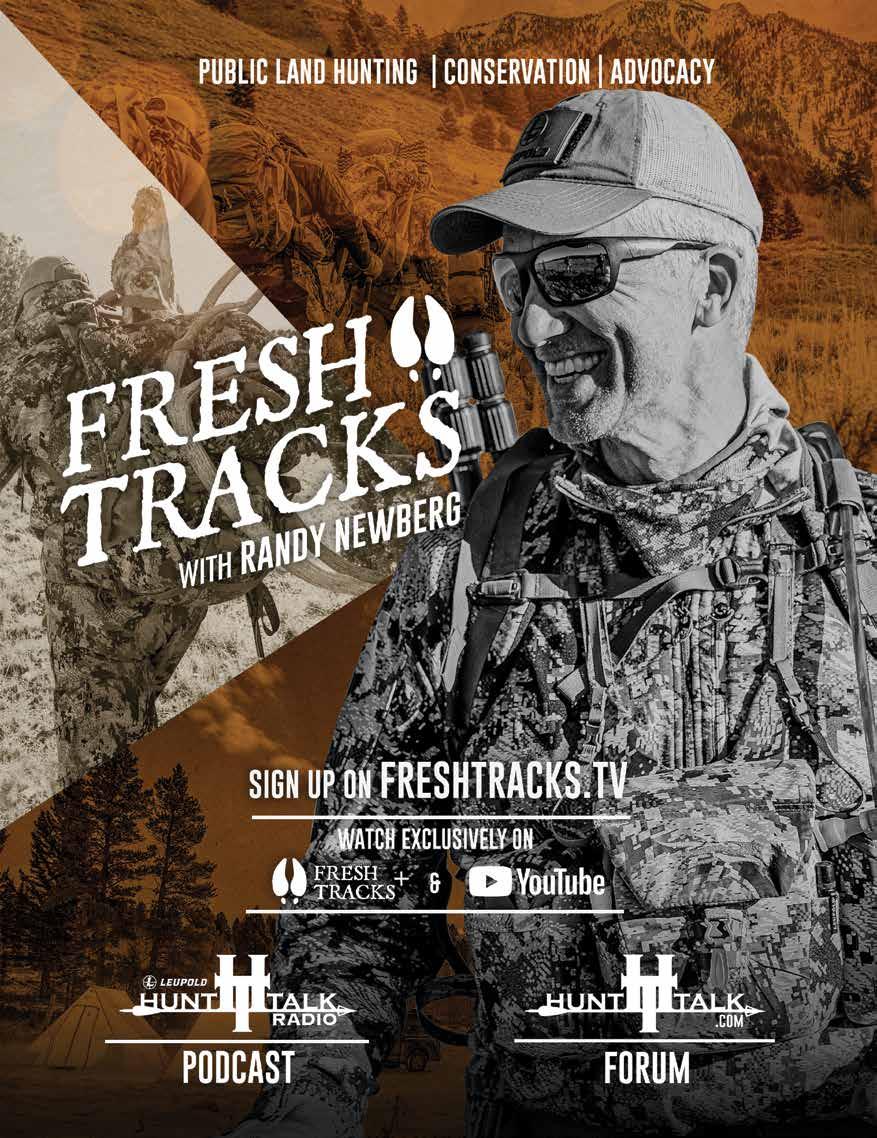

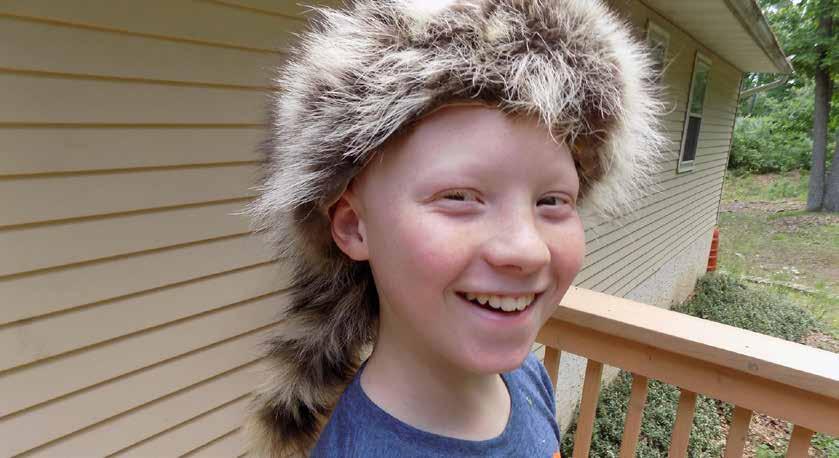
BY WILL CAVERLY
Before all of it fell out, my brother-in-law had a head of bright red hair. It suited Luke’s personality. I’d met him when he was a hyperkinetic 5-year-old bouncing off the walls, climbing trees and sprinting like a maniac for the ice cream truck. The red hair helped you keep track of him, kind of like a natural hunter’s orange. Useful, because he didn’t stay in one place for long.
Luke had been my hunting and homesteading mentee for a few years, which isn’t saying much because I was a “late-onset hunter” and barely knew what end of a gun to hold. I joined the Pennsylvania BHA chapter after reading about the Take 2 program, which asks Pennsylvania BHA members to take out at least two mentees a year. This has netted me enough mentees that I no longer have time to hunt with all of them. But Luke was the first.
As he turned 13, Luke’s fiery red mane started to disappear. I have an old email where my mother-in-law describes the situation. After she finished detailing to the extended family the upcoming marching band shows Luke would perform in, she used the rest of the email to tell us the bad news:
“I also want to update you on Luke. After his birthday party, he told us his hair was falling out. He has been diagnosed with alopecia. It is very noticeable and felt you guys need to know. He also has some bald spots. I drew lab work (thyroid, etc.) to see if that was the cause – it wasn’t. We had a dermatology appointment yesterday and the PA ordered more blood work to see if we can find out the cause. He has been given a shampoo and a treatment to be done each night to hopefully stimulate the hair follicles. If this doesn’t work, the next step is injections (tiny, tiny needle) into his head (steroid) to stimulate the hair follicles. Unfortunately, it will only get worse before it gets better. Another issue that might happen is as his hair grows in (in the beginning), it won’t have any
pigment. All is a wait and see. His teachers have also been notified and have been very supportive. They will allow him to wear a hat in school. Which is great. I think that is all.”
Tough news. We all felt horrible for him. Teachers could promise all kinds of support for Luke in the face of the disease, but anyone who has lived through middle school knows the social terrorism tweens inflict on each other. It’s truly the worst of times. I remember getting a bad haircut in seventh grade and going to school the next day to a horror show of insults and jeers. Kids will always be that way. As the red hair sloughed off in the shower or on his pillow, I can only imagine what was going through Luke’s 13-year-old mind. Nobody notices difference like a group of teenagers.
Yet my brother-in-law suffered alopecia with grace. Luke survived. It helped to have a few good friends. Everyone bought him beanies. The hats helped, not only with the new experience of scalp sunburn, but also with the inevitable questions about his health.
As far as I know, he did not punch anyone in the face at the Grammys. He might have felt like it, though. Nor did anyone slap a person on his behalf. I would have done it if he asked.
After watching Luke spend a tough winter going through hair loss, I decided to create something special, capitalizing on our shared love for the outdoors. It’d be a custom hat of a certain Americana flavor. Now, I’m no hatter. Most of my sewing experience comes from Home-Ec classes in high school and some failed attempts at hemming. Despite my lack of skill, a story about Benjamin Franklin provided irresistible inspiration. Allegedly, Franklin wore a coonskin cap on his diplomatic trip to France in the 18th century. Franklin’s charm and his country bumpkin look won the French over. Their French charm won over Franklin, too, who became a lifelong Francophile.
I was going to make Luke, my hunting mentee, a coonskin cap.
Not that I knew where to start. My wife and I had moved out to rural Pennsylvania a few years prior. I was raised in a vegetarian home and stayed in that dietary rut until age 25. (In case you were wondering, it was IHOP bacon that brought me to the dark side.) But I had been paying attention. “Trash pandas” frequented our little homestead. At night their coos, chatter and shrieks would sound through open windows. I hadn’t started big game hunting at that point and trapping seemed impossible. I had lots of good intentions and none of the equipment. But I did what so many do when facing adversity: I went on the internet to find an answer.
The internet of today feels much more sophisticated than it did ten years ago. It took some digging to find what I needed: grainy YouTube videos, sites coded in clunky-looking HTML, random message board threads where users had names like “BigBuckKiller69” and “Your_Redneck_ Revenge.” I learned that the hide of an animal needs preparation before it can become a hat.
First, there’s flensing. After skinning a creature, you must strip off every ounce of fat. If you missed anything, parts of the hide would go rancid and ruin your product. Then there’s the tanning. To create a pliable pelt, one that could be molded into a hat, you needed to choose a tanning method. Stretchdrying worked, but Pennsylvania summers are often rainy. Nor did I think my wife Sarah would let me bring that setup into the house.

Getting out of the car with my trash bag and gloves (I’d prepped those too, driving around for weeks, and probably would have been suspected as a serial killer if pulled over), I had that giddy, giggly feeling I’d get playing pranks as a kid.
There were caustic chemicals that could be applied for effective tanning. One recipe used bran flakes and battery acid. (Incidentally, Bran Flakes and Battery Acid would be a great name for a band.) That and other acidic solutions scared me off. A more sustainable and potentially badass method of tanning involved using brains. Also intimidating, I decided. Instead, I found a method that seemed foolproof, relatively non-toxic and didn’t involve brains – it used salt.
Alum looks a lot like table salt but has a few properties that make it useful for tanning. First, it’s highly antibacterial, which is great for biological material that’s going to be breaking down as soon as the animal expires. Second, it is great at preventing “hair slip,” where the animal’s hair follicle breaks down during the tanning process. If I was going to go through the trouble of making this hat, it needed to preserve the character of the fur. Third, it’s hard to hurt yourself with alum. I was making a “pickle,” and the last thing I wanted to do was end up with chemical burns.
My research got me most of the way. But internet research only gets you so far. I needed to get hands-on. I needed a dead raccoon.
I started researching traps, finally finding that the hand trap seemed to be the most effective and least likely to take off a finger. But before I could order any, fortune tipped me a carcass.
My wife fully supported this scheme. It was her little brother, after all. And she kept an eye out when passing through the most prolific source of dead raccoons, namely the country roadsides of her commute. One morning as I got ready for work, I got a call from Sarah. She’d left only a few minutes prior. I thought she’d forgotten her lunch and was turning around to get it.
“There’s a roadkill raccoon down the street,” she said. Her voice hit a peculiar note somewhere between excitement and good humor.
I remember a wave of anxiety hit me. I’d been preparing materials for weeks. I’d bought a draw knife to do the flensing after seeing someone use one in a YouTube video. I had a fivegallon bucket ready with sufficient alum standing by. I’d printed out more than a few guides on how to gut and skin an animal. But I hadn’t been committed before. Now I was. And I had to move fast. Timing means a lot when tanning an animal hide.
“Alright, I’m going to go get it,” I said.
“OK, I’m going to work; will you be OK?” Sarah replied.
“Absolutely,” I said, not at all sure that I would be.
I leapt into my Toyota Camry and drove a few hundred yards down our street. (If you’re going to go pick up roadkill, at least do it in a practical car.) The morning was clear and mild, which was a blessing. Heat would do a number on the critter’s corpse. The dead animal lay near a set of hedges on my neighbor’s property. It looked round, I remember, not at all flattened by whatever had hit it. That was good. It was also fresh. I’d commuted home the night before and would have seen it laying there, so the fatal event must have happened overnight, or early in the morning.
Getting out of the car with my trash bag and gloves (I’d prepped those too, driving around for weeks, and probably would have been suspected as a serial killer if pulled over), I had that giddy, giggly feeling I’d get playing pranks as a kid. The raccoon looked dead but didn’t look destroyed. Blood had pooled by its mouth. I apologized to him for how humans drove their automobiles. Slipping the surprisingly heavy corpse of the raccoon into the trash bag, I looked to make sure nobody was watching. Nobody
was. All decent people were at work being productive members of society. I was the only insane person stuffing dead animals into plastic bags for arts and crafts projects.
Maybe I “worked” from home that day. Maybe I called in sick. I can’t remember. I do remember gutting and fleshing out the hide as quickly as I could. It was a cathartic process, and it felt to me like my lizard brain recalled the movements in some primal way. Fear of rabies crept around in the back of my head, so I wore latex gloves for the skinning, though fluids made it up and over and coated my arms. Later, I’d find out that raccoons carry all kinds of other debilitating diseases. Raccoon roundworm can put you in a coma, and leptospirosis sometimes causes liver and kidney failure. I knew none of this. That was probably for the best.
Raccoons are greasy in a profound way. The only animal with greasier fat, I think, are sheep. Once, on a vacation in Iceland, I made mutton cutlets and ended up with tons of yellow fat globs that stuck to everything. The raccoon’s globular fat wanted to cling to every surface making for a filthy job.
But I started to enjoy myself the more I worked. Coon hides are thick and forgiving. All things considered they’re not a bad species to learn on. Making my salt pickle solution, I set the hide to soaking. Each day, before I went into the office, I’d visit the pickle and give it a stir, trying not to splash any of it on my work clothes.
I have another old email from that spring.
“I am making Luke a hat as a surprise. Can you do a measurement of his head, where a hat would sit? I was thinking a piece of string. It doesn’t have to be super accurate; I am just trying to get an idea.”
My mother-in-law responded that his head was 20.5 inches. I had my template.
A few weeks later, I removed the hide from the pickle to see if I had something workable. The hide dried flat overnight. By morning, it looked a little rough. The hide had a greasy raccoonfat patina that needed treatment. After shampooing with the same bottled stuff Sarah and I use on our own hair, the fur came to life. It had not slipped. The gray fur had the lustrous shine you’d see in a commercial for Garnier or Suave or Pantene. The next step involved making the hide more pliable, called “breaking.” Experts recommend making a newly tanned hide pliable by repeatedly kneading it in the hands. Some say that chewing is effective. I tried the chewing method briefly. Not for me.
As I worked, I got a chance to see colors I didn’t expect in the raccoon’s hair. The grays in the hide came in many different shades (50 or so), but that only represented the ends of each hair. The undercoat was jet black. The amber hairs of the tail weren’t something I’d ever noticed on a raccoon before.
For a moment, when working on the hide and holding the hair in my hands, I had a superstitious hope. Maybe wearing animal hair might push Luke’s scalp to start doing its job again. Maybe by infusing him with the spirit of this wild animal, he’d get the hair back. It was a strange thought.
I did my best to create a pliable hide, but it still had the roughness that one might expect from a roadkill raccoon’s hide soaked in pickling salt. My wife had an elegant solution: a silk liner she got from the thrift store with a minuteman theme. Benjamin Franklin never had it so good.
The hat came together easily, using some heavy gauge thread
driven by an oversize leather awl I ordered for the job. I put the work in to make sure that the hide’s various sections flowed well into one another. You didn’t want the lighter side colors to clash with the darker shades of the hide. The tail hung off the back, as God intended.
The whole family came over for a summer cookout. Nobody but my wife and I quite knew the nature of the hat Luke was about to receive. I don’t remember what was said, but I do remember everyone laughing. The hat fit perfectly. Luke’s only regret was that when he wore it, the cats in his house ran and hid and would not come out. It felt good to have helped.
Luke began steroid treatment. And for a while, it seemed the experimental approaches might work. The truth is that the mechanisms behind alopecia aren’t known. No treatment performs predictably. Luke showed off the lines of needle marks on his scalp. The hair came back, at first patchy, then arriving in full. Later, quarter-sized white spots created white streaks as Luke grew his hair long. The hair seemed darker this time around, the red less fiery and more burgundy in color. For a while, everyone hoped the alopecia was just a phase, maybe an artifact of teenage hormones. Some get their hair back after a brief spell of alopecia.
But a year passed, and his red hair started to drop again. And by 2017, three years after he first started to lose it, Luke lost all of his hair for the second time. It has not come back. That season, we ventured out into a swamp for a late season whitetail bowhunt, starting the morning off somewhere around zero degrees. We still laugh about it. Neither of us were at all prepared.
In January of 2021, Luke and I went to the Eastern Shore of Maryland on a guided hunt. We were pursuing sika deer, an invasive species of elk that has come to make its home in the salty costal swamps of Dorchester County. One of the guides pulled me aside a day into our trip. He said, “That boy, Luke, is he your son?”
Not an unexpected question. Luke and I are roughly eighteen years apart. He’s always been somewhere between a brother and a son to me. I told the guide that Luke was my brother-in-law.
“Does he have cancer or something? I mean, is this his last trip?”
I laughed. I guess rumors had spread around camp that Luke was going to meet his maker soon because of his bald head. No, I responded. This wasn’t a DIY Make-A-Wish. Luke just had alopecia. Annoying, disfiguring if you wanted to put it that way, but ultimately harmful only to his hair.
“Goddamn! I knew it!” my guide shouted, punching his fist in the air. “I knew there was some shit that wasn’t cancer that made your hair fall out!”
For a few days, Luke and I hunted the brackish waters of the Eastern Shore. Out there, you can taste the salt on the air. The trip was tons of fun, but we didn’t get anything. Later, Luke and I agreed that we should have told the guides that it was his last hunting trip before his untimely demise. Maybe they’d have put us in a better spot.
BHA member and bowhunter Will Caverly writes about history and the outdoors from his home in Chester County, Pennsylvania. His upcoming book deals with the intersection of eminent domain and the environment and is titled Tinicum & Eastwick: Environmental Justice and Racial Injustice in Southwest Philadelphia. You can find that and more of his work at willcaverly.com.
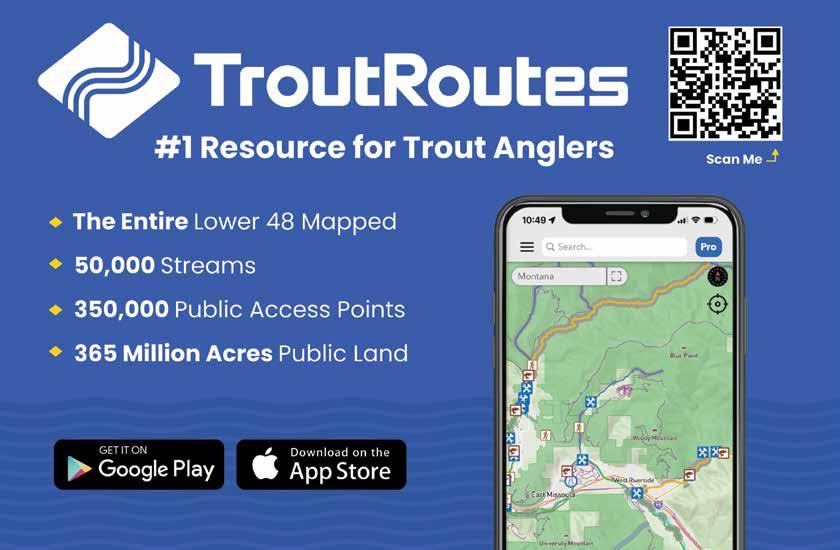

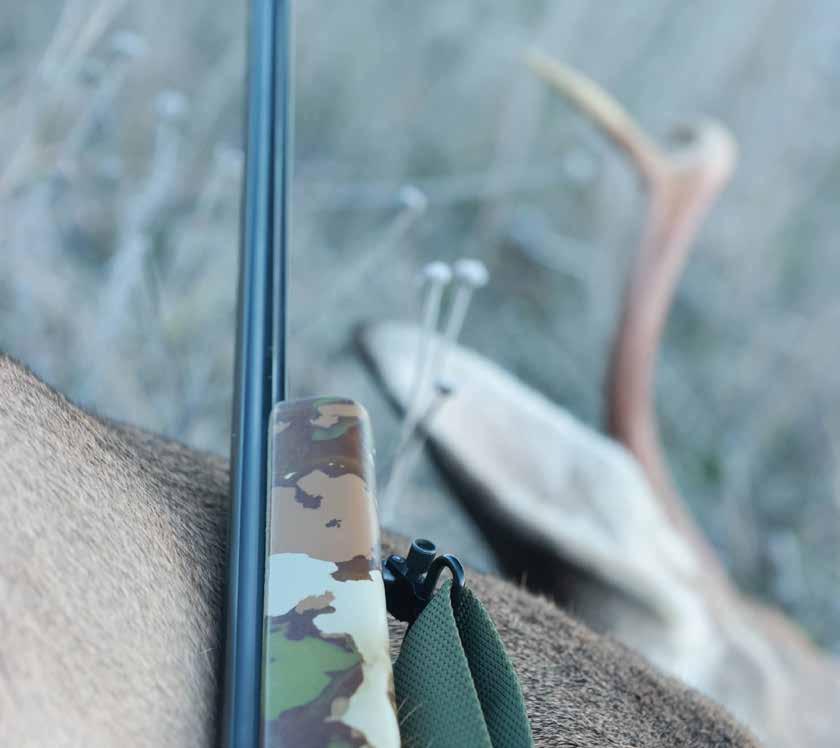

BY JILLIAN GARRETT
There is something deeply primal about hunting in the northern woods during late autumn. The vegetation has changed drastically from summer – becoming sparser as the warmth fades and the tamarack trees light up the forest with their botanical torchlight. In this landscape, you sit with your back against a tree, alone with your thoughts, the silence broken only by the gentle murmur of the wind through the forest and the manic chatter of squirrels on their daily industrious run for pinecones. Suddenly, you feel – more than hear – the steady drumming of a ruffed grouse, located so near to you that the beats almost seem to emanate from within your own chest. Momentarily, you become one with the landscape, not knowing where the forest ends and you begin. This is a side to human existence that you can only truly achieve as an active participant in the age-old dance of nature, and while the hunt may not always end in success, the memories created will be treasured for years to come.
As I am often fond of saying: Hunting is not a trip to the grocery store – there is never a guarantee of success. Not only does the animal have the option to get away, but many times it
doesn’t even deign to show up. This is something that I wish more non-hunters understood, and what I have finally begun to realize is that this lack of comprehension is mainly our fault, not theirs. As a hunting community, we always talk about our successes, but we rarely mention our failures – or any of the other aspects that make hunting so special. There exists such a high level of pressure in our world to be successful that it makes those of us who don’t fill a tag silent, and this does the future of hunting a disservice. By failing to portray the full story, we only build on the mistaken idea that hunting is the antithesis of fair chase. Doesn’t everyone just walk out into the woods and shoot a deer without any effort? Maybe it’s just because I have spent so much time on the outside looking in – a former vegan hiker morphed into adultonset hunter – which gives me a different perspective than those who were born into it. I can see the danger in failing to portray the full experience of the hunt – a danger that puts the very future of hunting at risk. While my social media feed fills up every autumn with countless images of successful hunters with bloody grip-and-grins, I can count on one hand the number of hunters who talk about “tag soup” or highlight the other aspects that make hunting such an incredible experience, regardless of whether a tag
These are all things that I never experienced during my time as a hiker, when my goal was always to get from one point to the next along the tunnel vision of a predetermined trail.
has been notched. Why does it take failing to be successful for us to spend more time talking about the complete experience that hunting provides?
When I see this trend, I understand why the non-hunting public views it as a bloodthirsty sport – and one that doesn’t give the animal a fair chance. Have we done anything to persuade them otherwise? The truth is that if the only goal of hunting was to simply kill an animal, we’d all just raise livestock. The experience is about so much more than that, and I think as a community we sometimes forget that fact. When it comes to the social acceptance of hunting, we can be our own worst enemies or our best PR campaigns –it all depends on how we portray the endeavor. It’s a salient point to keep in mind these days as hunter numbers continue to dwindle, and hunting comes ever more under attack from those who do not understand the realities of their food chain.
In recent years, I have finally begun seeing signs of pushback from those of us who understand the importance of telling the full story. Hunting is about the places you visit, the people you meet, the experiences you create, and even the meals that you make. While we should cheer for the successes of our hunts, the portrayal of that success should not be the only aspect of every story we tell. Not every hunt is successful, but every hunt is incredible, filled with unique experiences that feed the soul, even if they don’t always fill the freezer.
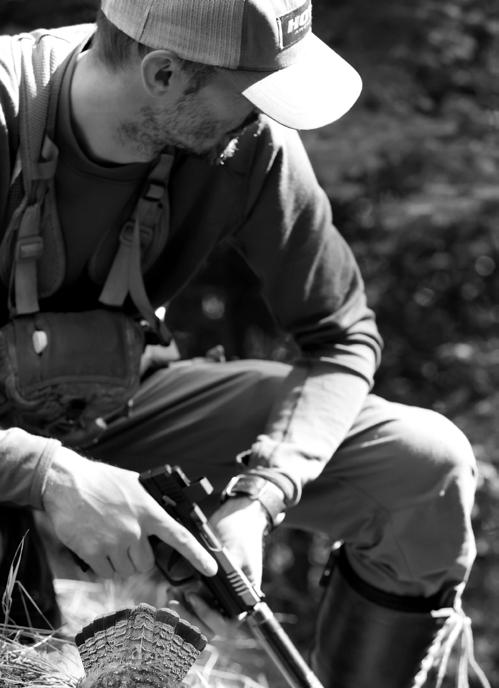
Over the years, I have hunted in sunshine, rain, blizzards, high winds (wondering if this would finally be the year I was killed by a falling tree), lightning and hail. I have walked countless miles, seen incredible vistas, and gone entire years without filling a single tag. I have heard the chirp of cow elk on cold, misty mornings and fallen asleep to the smell of sagebrush seas and the distant yips of coyotes. I have been puckeringly close to the contented purrgrowls of a cougar walking past me in the pre-dawn woods, the sound having the rumble of a hungry stomach and the resonance of a drumming ruffed grouse. I have stared into the eyes of the
biggest black bear of my life before he slowly turned to move off into the woods – that single moment of his back paw lifting and slipping through the barbed wire fence being burned into my brain forever. (I have lived entire lifetimes in the contemplation of that enormous, magnificent bear paw, and I never forgot the power of that encounter.) I have watched the most spectacular pink-hued sunrises, had the barrel of my rifle serve as a songbird perch, walked across muted-gold hayfields drenched in moonlight and bartered a mushroom for a squirrel’s silence in the woods. These are all things that I never experienced during my time as a hiker, when my goal was always to get from one point to the next along the tunnel vision of a pre-determined trail.
As a hunter, I have felt the joy of community, and seen the many ways that hunting brings people together – either through mentorship, help processing the harvest or even the often-difficult task of finding the animal in the first place. My journey as a hunter has been a river awash with the generosity of countless
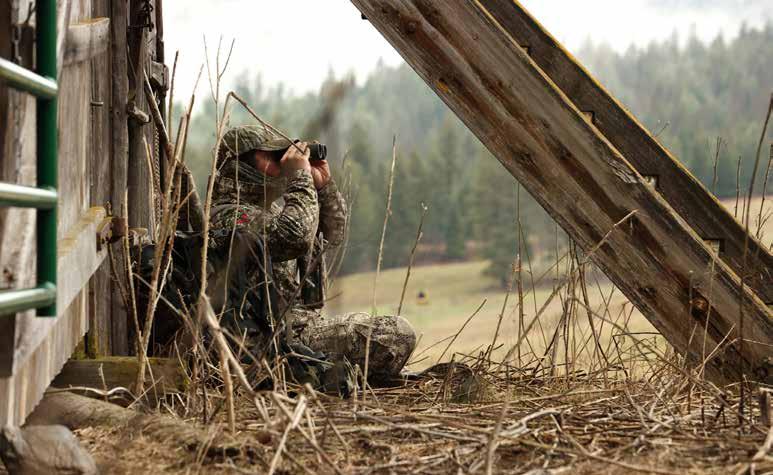
souls and brought me into contact with so many people that I might not otherwise have met. The friendships formed have been deep and lasting.
Just this year, I was blessed to receive permission to hunt bear on a local homestead that has been in the same family for 160 years – one that is known for rarely giving out hunting access. The owners welcomed me into their home and shared stories of their own hunts, as well as that of their family’s, on this extraordinary piece of land. While I didn’t harvest any bears there, I did enjoy watching the sun slip behind the mountains as deer came out to feed along the creek, with my husband sitting by my side, on a landscape filled with beauty – memories that will last us both a lifetime.
These are the features of hunting that we should be talking about because they are a vital part of the overall story. Hunting is not just about the harvest, but about the journey to get there and the people you are blessed to share it with. When we neglect to tell the full story of hunting, we do it – and ourselves – a disservice. Hunting may be deeply personal, but its portrayal is very public, and it’s important to keep that in mind when we talk about it. Whether we like it or not, the fight to save hunting is in part a fight for the social acceptance of it – something that gets more difficult each year as urbanization continues to increase, and people’s connection to their food grows ever more distant from reality. When we share those other aspects of the hunt, the ones that go beyond mere grip-and-grin success stories, we help to create an understanding that hunting is something far more special and spiritual. If we can show how hunting transcends simply killing an animal for food and instead intertwines an

important sense of community with a mode of cultural existence filled with memories and friendships and a reverence for the land and the animals we pursue, it is far more difficult to justify taking that away from us.
BHA member and author Jillian Garrett is a nationally published writer, photographer, hunter, farmer and conservationist living in northeast Washington State. She and her husband operate a regenerative farm with a focus on wildlife conservation through responsible land stewardship.


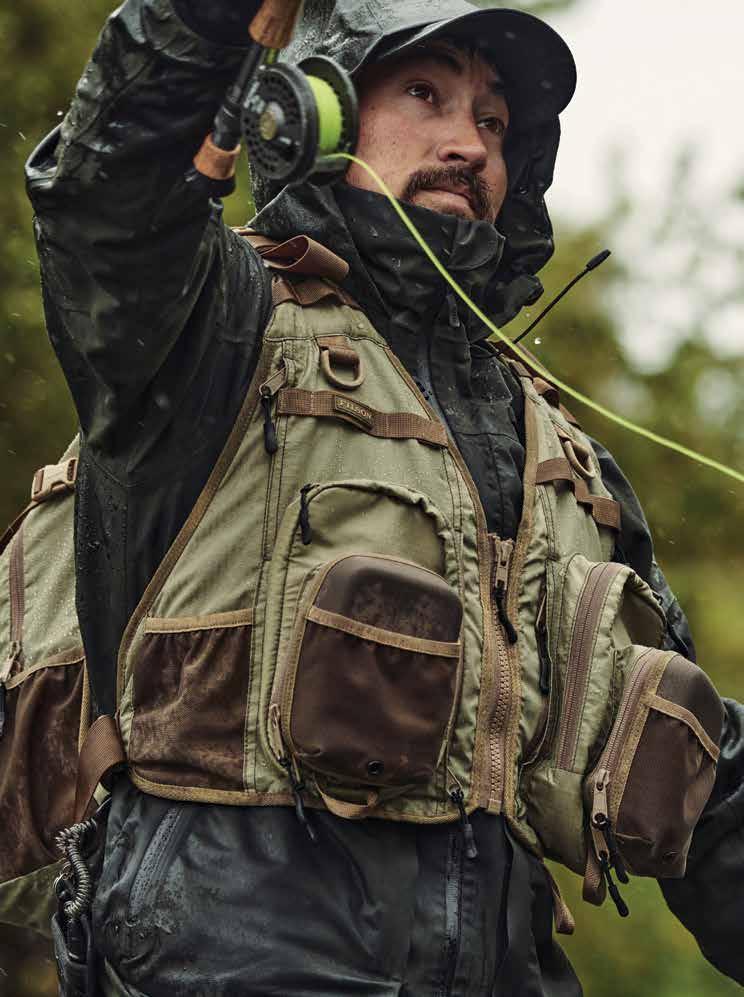



BY SEAN STINY
The bull sprig bellyflopped into the gut of the pond with a BB run through his wing, breath still in his lungs, life yet in his pounding heart. A crawl of buxom cumulus clouds dotted the sky he fell from on an otherwise bluebird day. His head popped out of the water bewildered. I popped out of the blind on approach as he paddled his webbed flippers in the opposite direction. Looking over his shoulder (wing, rather), I slowly gained on him. Finally, he dove under like an osprey (shoveler, rather) and a count-to-five later his long white neck emerged to see me, now within 10 feet. He dove under a second time and swam a diagonal line to confuse me. Surfacing, I was now within five feet. He took a gulp of air and dove again.
The water was brown and brisk and shin high. As I drew closer, I could see him paddling six-foot stretches beneath the shallow water. Frantic, coming up for a breath, then diving to again swim a diagonal away from me. He had me on the ropes – the dumb lumbering oaf who might stumble in the muck while he escaped into the maze of tules.
But his little heart soon grew tired, and when his long neck popped up at my right knee for a gasp of air, I snatched him. I could feel the warmth of life in his neck, the blood pumping from his heart, peering up at me, wide-eyed; I too a creature of this world. With a jerk of my wrist, it was over, his last trace of vigor dispatched. The sun was shining as a trickle of water ran off his back, and he and I calmly walked back to the blind.
Later, I carved out his breasts and little legs and sautéed his gizzard for offal on crackers. He then went into a plastic bag and into the trash can, awaiting Wednesday morning pickup. I am contrite that this is how he ends – his fanciful gray plumage and baby blue bill and copper-colored head now carrion for the landfill gulls. He goes back to the earth, but in grisly shameful fashion.

The snug bed sings a soft lullaby as the phone alarm calls out 2:45 a.m. – an end to the scant few moments of sleep. Time to strike north to the marshlands like a present-day pilgrim – an hour’s drive up the valley, caffeine-dependent. Surprisingly awake for this dark hour, moon in my rearview, a few disparate cars and 18-wheelers on the interstate. To where they’re going at this weary moment, I don’t dare question. Days in January spent in a blind clear the fog of my 9 to 5 malaise, assuage the disquiet in my mind.
The daily scourge of emails, meetings, calls, deadlines, spreadsheets, calendars, check-ins, commutes, co-workers replaced each weekend by blushing sunrises, stillness, wing beats, biting cold, working birds, mid-morning deli sandwiches, pitter pattering BBs hitting the pond, anticipation and long stretches of calm and solitude. For four duck hunting draws in January – two Saturdays, two Sundays – I make the long trudge to the blind in swampcolored neoprene, decoys on my back, Remington 12-gauge on my shoulder, through the boot sucking bog. The neoprene smells chemical, the shotgun like oil, the pond water sticky and dank.

In California, we have the refuge system up and down the Pacific Flyway. For a buck and change you can put in for one reservation per refuge per Wednesday, Saturday and Sunday.
Wednesdays, however, I occupy my cubicle refuge hammering away at the days sacrificed to a stranger’s bottom line.
Hunters mumble and shuffle in line at the 4 a.m. call time, a few with their dangling pre-dawn cigarettes. Two hours and change until we can open up on the birds. For now, the bureaucratic exchange of credentials with the fish and game consul at the dimly lit window is Step One of the day. Once each number is called, hunters clad in camo race back to their engorged trucks and gun it to the parking spot with rumors of the best tule pond. More often, they make a left at the second willow on the levy instead of a right, and set up in a pothole that nary a coot would take up residence. A coot. Only a luckless kid would shoot a hapless coot.
Not a person in my family is a waterfowler. I am self-motivated, along with some help from a generous co-worker, now hunting partner. I like it that way. Duck hunting is mine alone. It culminates in the three seconds that a sudden drake appears, locks its wings; I raise and lead my aim, and its crumpled body falls from the sky. The day-to-day toil of work and expectations and commitments vanishes at that moment, and I feel an obtuse sense of primordial
accomplishment in this deteriorating postmodern realm. Killing a brown-headed, male green-winged teal doesn’t prove a macho thing. But it does make me feel slightly more like a person in Roosevelt’s arena, something harder and harder to find the further we get into the 21st manmade century.

I awkwardly fling the last of my rinky dink decoys into the opaque water under cover of darkness. The pintail decoys will surely be seen by their namesake, the mallards however have become ghosts out here in the West. I have three little groups: mallard, sprig (pintail), and a couple darkish decoys, each slightly resembling the greenbandit wigeon. They all collectively resemble the dilapidated shed they came from, landing on Craigslist where I found them, and eventually into my little spread here in the dingy marsh water. I look up at the gibbous moon, it lingers silently in the inky sky and casts judgement on the crepuscular creatures below.
Finally, when the horned owl hoo-hoos in the daybreak and the dew hangs cold and heavy, I lie in wait on another red-letter day. The beating whoosh of teal wings as they rocket propel themselves over the pond like little ICBMs in the pinkish dawn that signal gotime has assuredly arrived.

The ducks are real, part of the world outside the artificiality of our own, and I crave them.
Beguiled by the owls calling to one another, triangulating their location, declaring this tree theirs and that one not, I pause to watch the sad-sack coots paddle by with their most peculiar of flippers. By mid-morning, the marsh hawks and speckled harriers arc over the pond, and a lonely bald eagle sweeps over the tules looking for a crippled teal to pick clean. In these moments, I discern the terrain with rapturous clarity.

I handle the bull sprig’s lifeless body delicately after I helicoptersnapped his neck, an obtuse gesture of compassion from one creature to another. What did you think when you looked down from above at this two-legged stumblebum kicking up water in your bayou? How did it feel to have a steel BB tear through your flecked gray wing rendering you flightless, helpless, soon lifeless? Is death apparent after my barrel explodes orange and your wing’s been shot out? Does the splashdown make you dizzy, make you see stars, suck the oxygen out of your lungs until you gasp them back full?
I sat back in that sullied blind and scanned the blue for the next bird, shell husks strewn to my left and right. Behind me the long-
necked sprig lay in the dried muck, a winged creature who saw and knew more of this earth than I ever could. His demise at my hand was a dastardly notch on my belt. But it made me feel closer to him and his marsh, to his wild place in this landscape. Something I have lost in the incessant push and pull of my tamed place on this earth.
The bull sprig now rests in my freezer, his feathers and insides long disposed, his fearlessness vanquished. I will consume him soon enough and, for a short time, inherit his wildness until it solemnly dissipates for good.
BHA member Sean Stiny grew up camping and fly fishing in the American West. A writer, woodworker and owl box maker, he lives in Petaluma, California.

ALASKA
Alaska Seaplanes
Aziak Equipment
FishHound Expeditions
Forbidden Peak Brewery
SageBrush Dry
Wild Rivers Coffee
CALIFORNIA Endurance Investments
COLORADO
Fossil Ridge Pack Llamas
Gunnison Fly Fishing Outfitters
Harmels
I Bar Ranch
Kate’s Real Food
MTNTOUGH
Rooted Apothecary
Ursack
White River Knives
Zeiss
IDAHO
Chisel Custom Decor
White Dog Brewing Co.
INDIANA
Moving Waters Outfitters
Two Forks Guide Service
KENTUCKY
Splatter
MONTANA cont.
RightOnTrek
The Trail Head
Timberline Ace Hardware
Zink’s Big Sky Archery Targets
NEVADA Elite Drywall
NEW ENGLAND Ridgeline Athlete

MONTANA
Adipose Boatworks Aziak Equipment Bella’s
Cambie Taphouse + Coffee Gastro
Grizzly Liquor
Lucca Scariano - Edward
OHIO Whuff Rod Company SOUTH DAKOTA
UTAH


BY JEFFREY PETERSEN
I shot a sideways glance at my hunting partner Nate as he navigated the two track out of the national forest by headlight, “You know we have to stop at the Checkerboard Inn, right?”
“Yeah, but do we?”
“Umm … yes. I’m not sure why, but we really need to check it out. It reminds me of the town I grew up in. Let’s call it a ‘cross-cultural’ experience.”
There was one day left of our first western hunt. As Michigan natives, we knew it would be a challenge to fill either the elk or deer tags of the Montana Combo License. After two years of buying points, online scouting and phone calls to wildlife biologists, we arrived in Central Montana ahead of the general season opener. Two gorgeous days of scouting in short sleeves were followed by seven hard, wet, cold days of hunting without pulling a trigger. The only elk spotted were casually strolling through private ranches as we drove past.
After hiking in and setting backcountry camps in two different locations, we landed in a section of national forest accessed by driving through a little community composed of everything from new construction to century-old hunting shacks. At the center of it all stood the Checkerboard Inn, a glorified pole barn built in stages by people who didn’t have a master plan. Of the possible entrances, we headed for the only one with a sign: a piece of white painted wood with “BAR” written in black, illuminated by a lavender lightbulb.
The BAR hummed with energy as a few dozen people occupied the mismatched furniture. After a week in the woods, I struggled to comprehend why a cheerleader, the Tin Man and a sexy nurse
would all be at the bar. Remembering that it was two days before Halloween, I figured we must have found the local costume party but maintained the possibility that this was just a normal Saturday night at the Checkerboard Inn.
We sat, dressed as tired hunters, at the only two empty bar stools. The last spot on the bar held a young man with a big smile who quickly introduced himself. Initial pleasantries established that we were Midwesterners on our first elk hunt, and he was “a dirtbag guide who chases elk and mulies all fall and rows a drift boat for trout all spring and summer.”
Our dirtbag neighbor wore Crocs plastered with clay and a puffy jacket with half a dozen duct tape patches. While waiting for a fresh beer, he pushed around two empty pint glasses with crud-caked fingernails. He had a three-day break between paying clients and was in town to meet up with an old friend who had yet to get an elk. The conversation flowed easily, comparing notes from the first week of the general season to the salmonfly hatch of Montana and the hex hatch of Michigan, to tasting notes as we worked through the IPAs from behind the bar.
After a few hours and a pizza, we said we ought to head to camp to get some sleep before our last full day of hunting. He looked at us with genuine sympathy, “Sorry you guys didn’t get into any elk. Maybe tomorrow.”
Nate replied, “At this point any legal deer is in trouble.”
“Seriously? Well, I ain’t going to give you my f***ing elk spots. But, if all you want is a mule deer, let me tell you where you need to go!”
“Seriously?”
“Yeah, you got onX?”
I gave him my number, and texts containing pins throughout the
I decided to stop in the men’s room before ending our first visit to the Checkerboard Inn. The toilet was off its base and leaning in the corner. In its place was a handwritten sign: “Plenty of bushes outside.” I called Nate over. “Told you we needed to stop here.”
eastern half of the state starting popping up on my phone. As he sent the last one, he revealed the source of his generosity.
“I used to guide for an absolute jackass out in that area. One day I went to collect what he owed me and found him cooking meth in his garage. I was like, ‘Whatever, man. Stiff me if you want, but I’m sending everyone I know to your honey holes.’”
Nate and I stole a glance at each other. What could go wrong?
Just about then his friend showed up, and they started scheming about the next day’s hunt. Nate and I had a quick conversation about drive times before deciding to set a 2:30 a.m. alarm and head east. As we got up from the bar I grabbed the guide’s attention.
“Hey man, thanks again for the lead. We’re trusting that you’re not messing with us.”
“No way, you’ll get a shot at a deer out there. I guarantee it.”
“That’s a bold promise!”
“You gotta be bold, or you eat tag soup!”
Anticipating a short, cold night ahead, I decided to stop in the men’s room before ending our first visit to the Checkerboard Inn. The toilet was off its base and leaning in the corner. In its place was

a handwritten sign: “Plenty of bushes outside.” I called Nate over. “Told you we needed to stop here.”
Thirty-six hours later we were on the road home with a 75-liter cooler full of mule deer meat and the respectable 3x4 rack of the buck that Nate had shot at dusk while still-hunting through a onesquare-mile section of state land. There was no sign of the deadbeat methhead. Not long after crossing into Wyoming we regained cell coverage and sent our BAR benefactor a picture of Nate and his deer along with a word of thanks. The reply came back an hour later, “Boom! Nice work! Better than tag soup, am I right?”
Not every story has a moral, but this one does: When a selfdescribed dirtbag guide in an elk-town dive bar gives you a tip, take it.
Jeffrey Petersen is a BHA life member and Michigan chapter chair. He lives in Grand Rapids with his wife and two teenage sons who graciously let him take public land adventures to parts unknown.





BY JAN DIZARD
I began serious bird hunting when I got my first bird dog, a male German shorthaired pointer. Independently, I met and quickly befriended another adult-onset hunter who also had his first bird dog, a Brittany. Our friendship deepened easily – we were both young professors working toward tenure, and our boys were the same age and became friends, too. As only good friends do, we teased one another about whose dog was better and who could shoot better –the sorts of things that could be fighting words between strangers.
After two years of hunting together, a pattern emerged: He was a better wing shot, and I was a better dog trainer. More specifically, my dog was a steady pointer, and his dog busted many more birds than she pointed. The result was I became a decent shot when I hunted pheasants because my dog gave me time to get in position and be ready for the flush. Easy shooting. My friend was incredibly fast, and it didn’t matter that his dog busted birds – he was deadly on woodcock.
In our third or fourth year of hunting together, we made a wager just before the season opened: Whoever got the most birds by the end of the season would get a case of beer.
The season unfolded true to form. I shot many more pheasants than he did, we tied on grouse, and he cleaned my clock on woodcock. He won. Jokingly, I suggested a revision of the competition – who got the heaviest game bag. I bought the beer.
Several weeks later, over a couple of the beers I’d bought, we spontaneously shared a revelation we’d both had: What started as a friendly competition had devolved into a determination to win. Neither of us cheated or violated game laws, but hunting became less satisfying for both of us. We stopped savoring it.
Of course, my friend enjoyed winning. But we both recognized we were focused on killing, not the delight of being outdoors with a friend. Not enjoying our dogs working a running pheasant, a grouse erupting from the brush in a thunderous explosion, or a woodcock
flushing through impenetrable alders like a pinball. We had hunted for the wrong reason, and it spoiled the season for both of us.
The focus on killing as many as the law allows for bragging rights, prize money or even a case of beer tilts the hunt away from the intrinsic reasons we hunt: the challenge of matching wits with an animal whose habits and behavior vary based on the season, weather, feed, and time of day – variables a hunter must master.
To be sure, it’s frustrating to master those variables and still fail because we miss shots, the dog has a bad day, a branch deflects an arrow, the birds won’t hold or the woodcock zigs just as the trigger is pulled. But these “failures” are what make hunting a hunt, not a kill. Killing isn’t everything. It isn’t even necessary.
What is necessary is intent. Going afield with a gun or bow is different from a walk in the woods. The intent, being prepared to shoot, puts our senses on full alert, makes our awareness of our surroundings salient. And, crucially, we understand that we have entered into an active predator/prey world. We become actors in a timeless cycle, not spectators. If we do manage to make a good shot, fine – it’s frosting on the cake.
But what my friend and I learned years ago, when we were, to quote a young Aldo Leopold, “full of trigger itch,” is that turning the hunt into a contest warped things. It made killing and only killing the central focus. It reduced the birds we shot to mere tokens to be added up at the end of the season. Competition and prizes may in some cases bring out the best in us; but in hunting, it can crowd out the more lasting and meaningful satisfaction of hunting well.
BHA member Jan Dizard is a board member of Orion and an avid bird hunter and fisherman. A retired professor, he lives in Chico, California. His most recent hunting-related book, Hunting: A Cultural History, (written with Mary Zeiss Stange), was published by MIT Press in 2022.
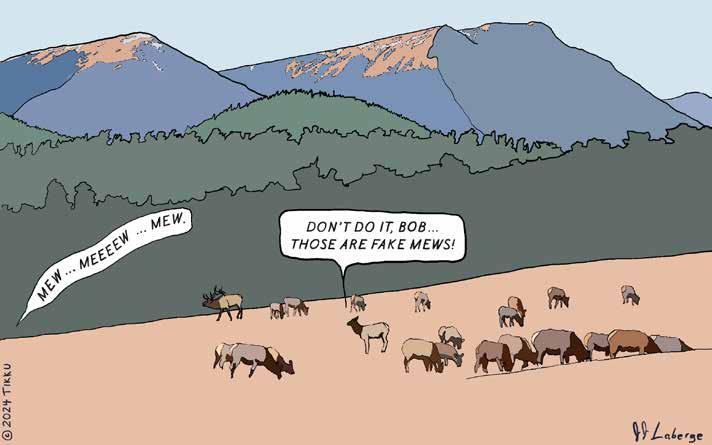
Comic: BHA member JJ Laberge is the creator of Clade & Genus, an online comic that focuses on the business of nature. His inspiration comes from spending time in the outdoors within Northern Ontario’s vast public lands pursuing whitetail, moose, ruffed grouse and woodcock. You can find Clade & Genus on Instagram @cladeandgenus or online at www.cladeandgenus.com
You can choose to make one donation at a time or become a sustaining donor and make monthly donations. All donations are fully tax-deductible and go toward securing the future of hunting and angling –ensuring that you have access to public lands and waters and healthy fish and wildlife habitat when you get there.
Our shared lands, our responsibility. We are working to diversify our funding sources to ensure that BHA will always be working on behalf of our wild public lands, waters and wildlife – for generations to come –by establishing a $1 million endowment. This investment will grow and become a perpetual funding stream that exists to support the future needs of our organization, regardless of any unpredictable challenges beyond our influence. Give today to form the root structure that will sustain BHA for many years to come.

Including Backcountry Hunters & Anglers in your plans for the future will create a long-lasting impact for our wild public lands, waters and wildlife. Your commitment to BHA will allow the next generation of conservation leaders to continue our work as part of your legacy. Including BHA in your will, trust, retirement account or life insurance policy is one of the easiest and quickest ways to support the future.
Support BHA every time you search online by using search engine Bing’s Give Mode.
Please contact admin@backcountryhunters.org or visit backcountryhunters.org/donate for more ways to support BHA.






BY JENNY NGUYEN-WHEATLEY
Bolognese is the meat sauce of all meat sauces. It’s hearty and rich, made by slow-simmering ground meat for hours with a bit of milk for added decadence. The amazing flavor can be attributed to the technique – concentrating and building flavors – and being patient. It lends itself well to wild game and is perfect with ground duck meat.
I suggest making Bolognese a day ahead, which makes serving easy the following day. To serve, all you have to do is reheat in a pan with a bit of pasta water before tossing in the noodles. Bolognese also freezes well.
Drink the white wine while you cook, because the finished sauce tastes best with a dry red, such as Sangiovese or Barbera.
Servings: 4-6
Prep Time: 10 minutes
Cooking Time: 3 hours and 30 minutes
INGREDIENTS:
• 1 pound of ground duck or goose
• 1 tbsp olive oil
• 2 ribs of celery, chopped
• 1 carrot, peeled and chopped
• 1 medium onion, chopped
• 3 ounces of pancetta, finely chopped
• 1 bay leaf
• 2 cloves of garlic, minced
• 1/3 cup of tomato paste
• Pinch of nutmeg
• Pinch of red pepper flakes*
• 1 cup of dry white wine
• 2 cups of low-sodium chicken stock
• 1 cup of whole milk
• 1 pound of pappardelle pasta
• Grated Parmesan cheese, for serving
• Kosher salt and freshly ground pepper
* If you have it, substitute red pepper flakes with 1 teaspoon of Trader Joe’s Italian-style Soffritto Seasoning.
1. Pulse the chopped celery, carrot and onion in a food processor until finely chopped. Set aside.
2. In a heavy-bottomed medium pot, heat one tablespoon of olive oil over medium-high heat. Break up the ground duck into large chunks and add them to the hot oil. Allow this first side to form a nice crust before breaking up the meat with a wooden spoon and cooking through. Season with a pinch of salt and then transfer the meat to a plate and set aside.
3. Lower heat to medium and add the finely chopped pancetta to render and crisp. Then add the finely chopped vegetables and cook until most of the moisture has evaporated, and it starts to stick to the bottom of the pan, stirring often. Next, add the bay leaf, minced garlic, tomato paste, nutmeg, red pepper flakes and a pinch of salt. Cook for two minutes, stirring often.
4. Return the cooked duck to the pot. Pour in one cup of dry white wine and cook, stirring often, until the wine is nearly all evaporated, while using a wooden spoon to break up the meat as finely as you can.
5. Next, add two cups of chicken stock and one cup of whole milk. Bring to a simmer and then cook on low, uncovered, for 2.5 hours or longer, until the meat is completely tender. Stir occasionally. Add more stock or water as needed to prevent scorching. Season to taste with salt and pepper.
6. It’s best to cook only as much pasta as you’d eat at one sitting. Undercook the pappardelle pasta in boiling water. In a pan, add Bolognese sauce to taste and heat on low. Transfer the undercooked pasta to the sauce, adding a bit of pasta water to loosen up the sauce to toss. The pasta will cook the rest of the way during this time. Season to taste. Serve immediately with grated Parmesan cheese.
BHA member Jenny Nguyen-Wheatley is a hunter, writer and editor in Omaha, Nebraska. In addition to her role as full-time associate editor at Nebraskaland Magazine, she runs the wild game cooking blog Food for Hunters and is a regular contributor to BHA’s Field to Table column and blog.



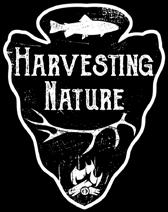




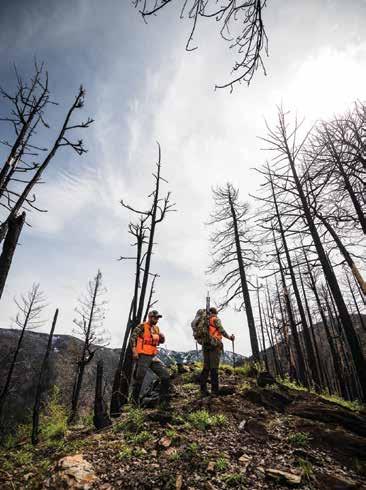


INTRODUCING OUR FULLY REENGINEERED WHITETAIL SYSTEM.
We invited arguably the most dedicated whitetail hunters in the country to share their ideas and provide detailed product feedback. Taking that potent knowledge, we developed a line that breaks the mold of the common seasonal system. We then turned the gear over to our pro team to give it their worst. After extensive testing and tuning, we now offer you an all-new whitetail system that truly makes a difference.
SCAN THE QR CODE TO FIND YOURS


Recently, I found my mind wandering back to 2017. The prompt was a BHA call I’d just gotten off, and the subject was all too familiar: Politicians in Utah were trying to take OUR public land. Déjà vu. History repeating itself.
It was through that 2017 attempt by Rep. Chaffetz that I found BHA – a grassroots organization that ignited a firestorm, with Chaffetz withdrawing his bill and even apologizing only eight days later. The representative had seemingly found some sobering humility – or just realized a losing cause – and I’d found something I’d been looking for: a group that wasn’t afraid to stand up for wild places and say what needed to be said.
Less than two years later, I found myself standing in a jampacked, small and pragmatic (some might even say grimy) BHA Headquarters’ office in Missoula, Montana. I was there with staff and local members for the annual holiday party. Though the mood was festive, my presence likely came off a bit more serious; I was there as part of a third interview for the Journal editor position. Truth be told, that was an absolutely miserable way for an introvert (who prefers the solitude of the backcountry and the written word) to have to interview for a job. But I was there to interview them, too. Who were these people? Did they really see the world through a similar lens, care about the same things, as I did?
That night, I met staff, interns and members who I’m proud to call friends still to this day. And at the end of the night, President & CEO Land Tawney said a few words to the crowded room about BHA and about the value of our wild public lands, waters, and wildlife. He concluded with a few simple words that stuck with me to this day: “BHA is ALWAYS going to do what is right for conservation.”
That’s when I knew I’d found my place – an organization that
won’t be swayed by political or corporate pressure or because the work is hard. We’re going to do what’s right to ensure North America’s outdoor heritage of hunting and fishing in a natural setting, through education and work on behalf of wild public lands, waters, and wildlife. Obviously, I took the job.
This all brings me back to Utah. Here we are seven years later; a lot has changed at BHA. New faces and new threats to our wild public lands, waters and wildlife. But also some of old: While Chaffetz saw the light, many of those same-ol’ greedy Utah politicians are at it again, putting a fresh spin on their same-ol’ effort to take our public lands – to the tune of 18.5 million acres of BLM land – for the benefit of themselves and their wealthy buddies. Their campaign is all smoke and mirrors, hiding their intentions to reap profit from our shared resource in any and every way conceivable – at a tremendous cost to the rest of us.
With $10 million in campaign money, and a $14 million lawsuit backing them, Utah officials are probably wondering who could possibly stand in their way.
I’m glad to answer: BHA is; WE are. We may be tired of history repeating itself – of sending emails, making calls – of this same ol’ battle. But we’re the ones who must answer the call and do what’s right for conservation, not just us but for our kids and our kids’ kids. So they, too, can someday stalk mule deer in the sage or camp next to the Green and cast to rising trout, or simply wander through a slot canyon in awe.
-Zack Williams, editor
Learn more about Utah’s public lands grab and get involved at www. utahisnotforsale.org
